Logistics Performance Index Analysis
VerifiedAdded on 2020/01/28
|30
|7701
|424
Journal and Reflective Writing
AI Summary
This assignment focuses on analyzing the Logistics Performance Index (LPI) of several countries, including Singapore, South Korea, Malaysia, China, and Papua New Guinea. Students are tasked with creating a table showcasing each country's LPI score and performance across various indicators like customs, infrastructure, international shipments, logistics competence, tracking & tracing, and timeliness. Furthermore, the assignment requires students to discuss the implications of these varying LPI scores for Australia's import and export activities with these countries.
Contribute Materials
Your contribution can guide someone’s learning journey. Share your
documents today.

Diploma of Logistics Module 1 Assignment 160812
TLIL5055, TLIU0001, TLIU5006, BSBRSK501
Diploma of Logistics
Module 1 Assignment
Submission Instructions:
Key steps that must be followed:
1. Please complete the Declaration of Authenticity at the bottom of this page.
2. Once you have completed all parts of the assessment and saved it (eg. to your
desktop computer), login to the Monarch Learning Management System (LMS) to
submit your assessment.
3. In the LMS, click on the file ”Submit Dip LogisticsModule 1 Assignment” in the
Module 1 section of your course and upload your assessment file/s by following
the prompts.
4. Please be sure to click “Continue” after clicking “submit”.This ensures your
assessor receives notification – very important!
Declaration of Understanding and Authenticity *
I have read and understood the assessment instructions provided to me in the Learning Management System.
I certify that the attached material is my original work. No other person’s work hasbeen used without due
acknowledgement. I understandthat the work submitted may be reproduced and/or communicated for the purpose
of detecting plagiarism.
.
Student Name*: Date:
* I understand that by typing my name or inserting a digital signature into this box that I agree and am bound by the
above student declaration.
1
TLIL5055, TLIU0001, TLIU5006, BSBRSK501
Diploma of Logistics
Module 1 Assignment
Submission Instructions:
Key steps that must be followed:
1. Please complete the Declaration of Authenticity at the bottom of this page.
2. Once you have completed all parts of the assessment and saved it (eg. to your
desktop computer), login to the Monarch Learning Management System (LMS) to
submit your assessment.
3. In the LMS, click on the file ”Submit Dip LogisticsModule 1 Assignment” in the
Module 1 section of your course and upload your assessment file/s by following
the prompts.
4. Please be sure to click “Continue” after clicking “submit”.This ensures your
assessor receives notification – very important!
Declaration of Understanding and Authenticity *
I have read and understood the assessment instructions provided to me in the Learning Management System.
I certify that the attached material is my original work. No other person’s work hasbeen used without due
acknowledgement. I understandthat the work submitted may be reproduced and/or communicated for the purpose
of detecting plagiarism.
.
Student Name*: Date:
* I understand that by typing my name or inserting a digital signature into this box that I agree and am bound by the
above student declaration.
1
Secure Best Marks with AI Grader
Need help grading? Try our AI Grader for instant feedback on your assignments.
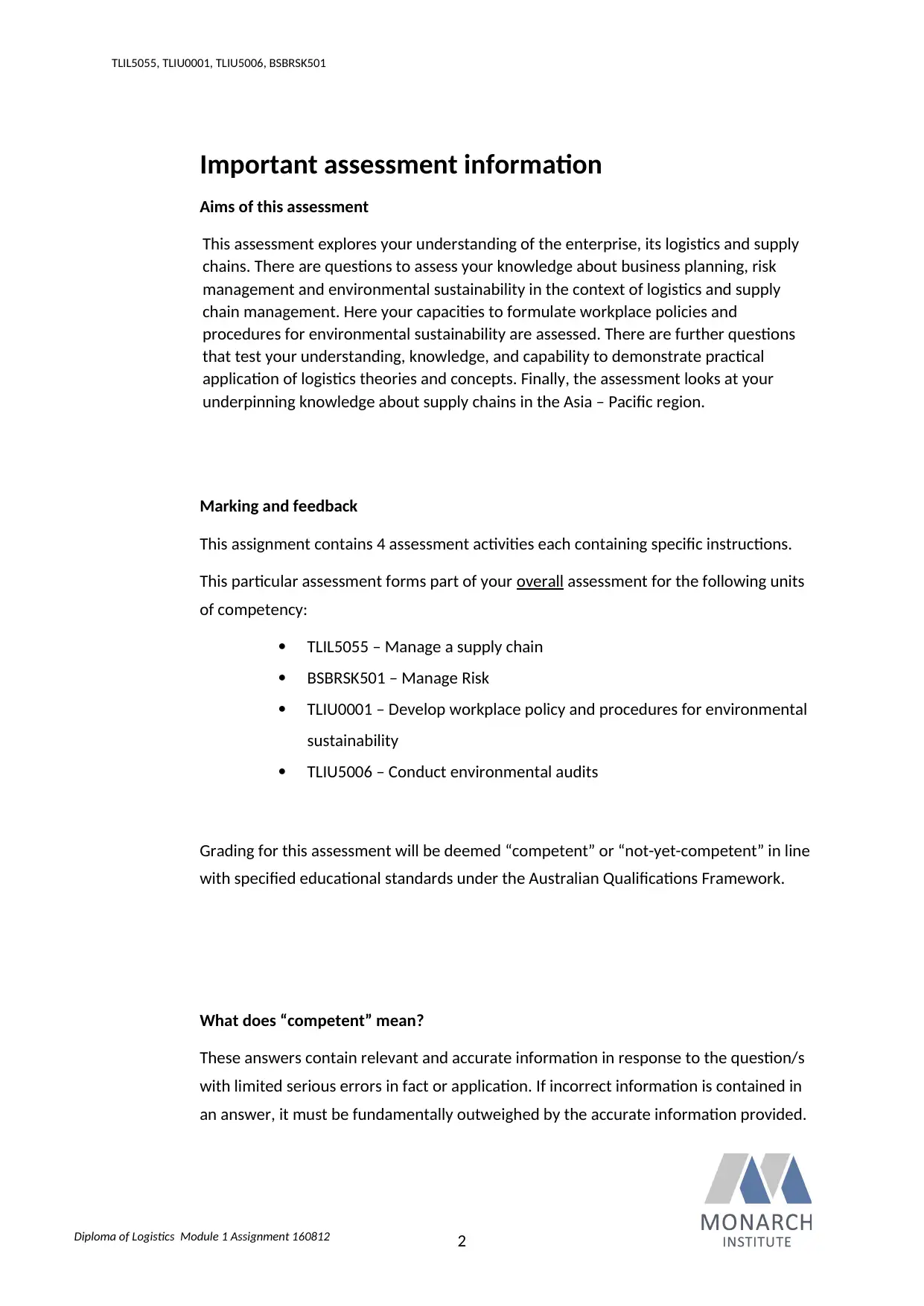
Diploma of Logistics Module 1 Assignment 160812
TLIL5055, TLIU0001, TLIU5006, BSBRSK501
Important assessment information
Aims of this assessment
This assessment explores your understanding of the enterprise, its logistics and supply
chains. There are questions to assess your knowledge about business planning, risk
management and environmental sustainability in the context of logistics and supply
chain management. Here your capacities to formulate workplace policies and
procedures for environmental sustainability are assessed. There are further questions
that test your understanding, knowledge, and capability to demonstrate practical
application of logistics theories and concepts. Finally, the assessment looks at your
underpinning knowledge about supply chains in the Asia – Pacific region.
Marking and feedback
This assignment contains 4 assessment activities each containing specific instructions.
This particular assessment forms part of your overall assessment for the following units
of competency:
TLIL5055 – Manage a supply chain
BSBRSK501 – Manage Risk
TLIU0001 – Develop workplace policy and procedures for environmental
sustainability
TLIU5006 – Conduct environmental audits
Grading for this assessment will be deemed “competent” or “not-yet-competent” in line
with specified educational standards under the Australian Qualifications Framework.
What does “competent” mean?
These answers contain relevant and accurate information in response to the question/s
with limited serious errors in fact or application. If incorrect information is contained in
an answer, it must be fundamentally outweighed by the accurate information provided.
2
TLIL5055, TLIU0001, TLIU5006, BSBRSK501
Important assessment information
Aims of this assessment
This assessment explores your understanding of the enterprise, its logistics and supply
chains. There are questions to assess your knowledge about business planning, risk
management and environmental sustainability in the context of logistics and supply
chain management. Here your capacities to formulate workplace policies and
procedures for environmental sustainability are assessed. There are further questions
that test your understanding, knowledge, and capability to demonstrate practical
application of logistics theories and concepts. Finally, the assessment looks at your
underpinning knowledge about supply chains in the Asia – Pacific region.
Marking and feedback
This assignment contains 4 assessment activities each containing specific instructions.
This particular assessment forms part of your overall assessment for the following units
of competency:
TLIL5055 – Manage a supply chain
BSBRSK501 – Manage Risk
TLIU0001 – Develop workplace policy and procedures for environmental
sustainability
TLIU5006 – Conduct environmental audits
Grading for this assessment will be deemed “competent” or “not-yet-competent” in line
with specified educational standards under the Australian Qualifications Framework.
What does “competent” mean?
These answers contain relevant and accurate information in response to the question/s
with limited serious errors in fact or application. If incorrect information is contained in
an answer, it must be fundamentally outweighed by the accurate information provided.
2
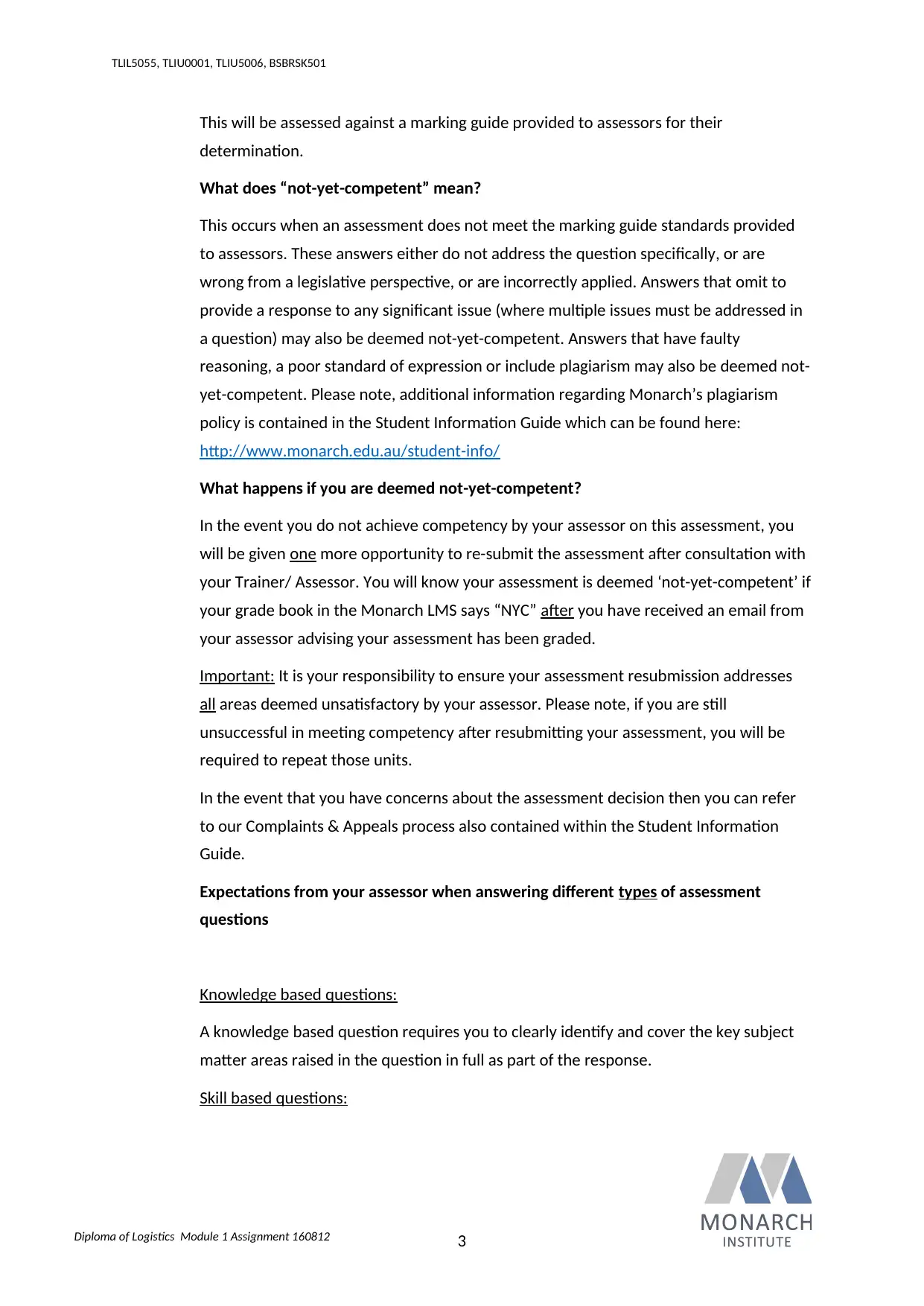
Diploma of Logistics Module 1 Assignment 160812
TLIL5055, TLIU0001, TLIU5006, BSBRSK501
This will be assessed against a marking guide provided to assessors for their
determination.
What does “not-yet-competent” mean?
This occurs when an assessment does not meet the marking guide standards provided
to assessors. These answers either do not address the question specifically, or are
wrong from a legislative perspective, or are incorrectly applied. Answers that omit to
provide a response to any significant issue (where multiple issues must be addressed in
a question) may also be deemed not-yet-competent. Answers that have faulty
reasoning, a poor standard of expression or include plagiarism may also be deemed not-
yet-competent. Please note, additional information regarding Monarch’s plagiarism
policy is contained in the Student Information Guide which can be found here:
http://www.monarch.edu.au/student-info/
What happens if you are deemed not-yet-competent?
In the event you do not achieve competency by your assessor on this assessment, you
will be given one more opportunity to re-submit the assessment after consultation with
your Trainer/ Assessor. You will know your assessment is deemed ‘not-yet-competent’ if
your grade book in the Monarch LMS says “NYC” after you have received an email from
your assessor advising your assessment has been graded.
Important: It is your responsibility to ensure your assessment resubmission addresses
all areas deemed unsatisfactory by your assessor. Please note, if you are still
unsuccessful in meeting competency after resubmitting your assessment, you will be
required to repeat those units.
In the event that you have concerns about the assessment decision then you can refer
to our Complaints & Appeals process also contained within the Student Information
Guide.
Expectations from your assessor when answering different types of assessment
questions
Knowledge based questions:
A knowledge based question requires you to clearly identify and cover the key subject
matter areas raised in the question in full as part of the response.
Skill based questions:
3
TLIL5055, TLIU0001, TLIU5006, BSBRSK501
This will be assessed against a marking guide provided to assessors for their
determination.
What does “not-yet-competent” mean?
This occurs when an assessment does not meet the marking guide standards provided
to assessors. These answers either do not address the question specifically, or are
wrong from a legislative perspective, or are incorrectly applied. Answers that omit to
provide a response to any significant issue (where multiple issues must be addressed in
a question) may also be deemed not-yet-competent. Answers that have faulty
reasoning, a poor standard of expression or include plagiarism may also be deemed not-
yet-competent. Please note, additional information regarding Monarch’s plagiarism
policy is contained in the Student Information Guide which can be found here:
http://www.monarch.edu.au/student-info/
What happens if you are deemed not-yet-competent?
In the event you do not achieve competency by your assessor on this assessment, you
will be given one more opportunity to re-submit the assessment after consultation with
your Trainer/ Assessor. You will know your assessment is deemed ‘not-yet-competent’ if
your grade book in the Monarch LMS says “NYC” after you have received an email from
your assessor advising your assessment has been graded.
Important: It is your responsibility to ensure your assessment resubmission addresses
all areas deemed unsatisfactory by your assessor. Please note, if you are still
unsuccessful in meeting competency after resubmitting your assessment, you will be
required to repeat those units.
In the event that you have concerns about the assessment decision then you can refer
to our Complaints & Appeals process also contained within the Student Information
Guide.
Expectations from your assessor when answering different types of assessment
questions
Knowledge based questions:
A knowledge based question requires you to clearly identify and cover the key subject
matter areas raised in the question in full as part of the response.
Skill based questions:
3
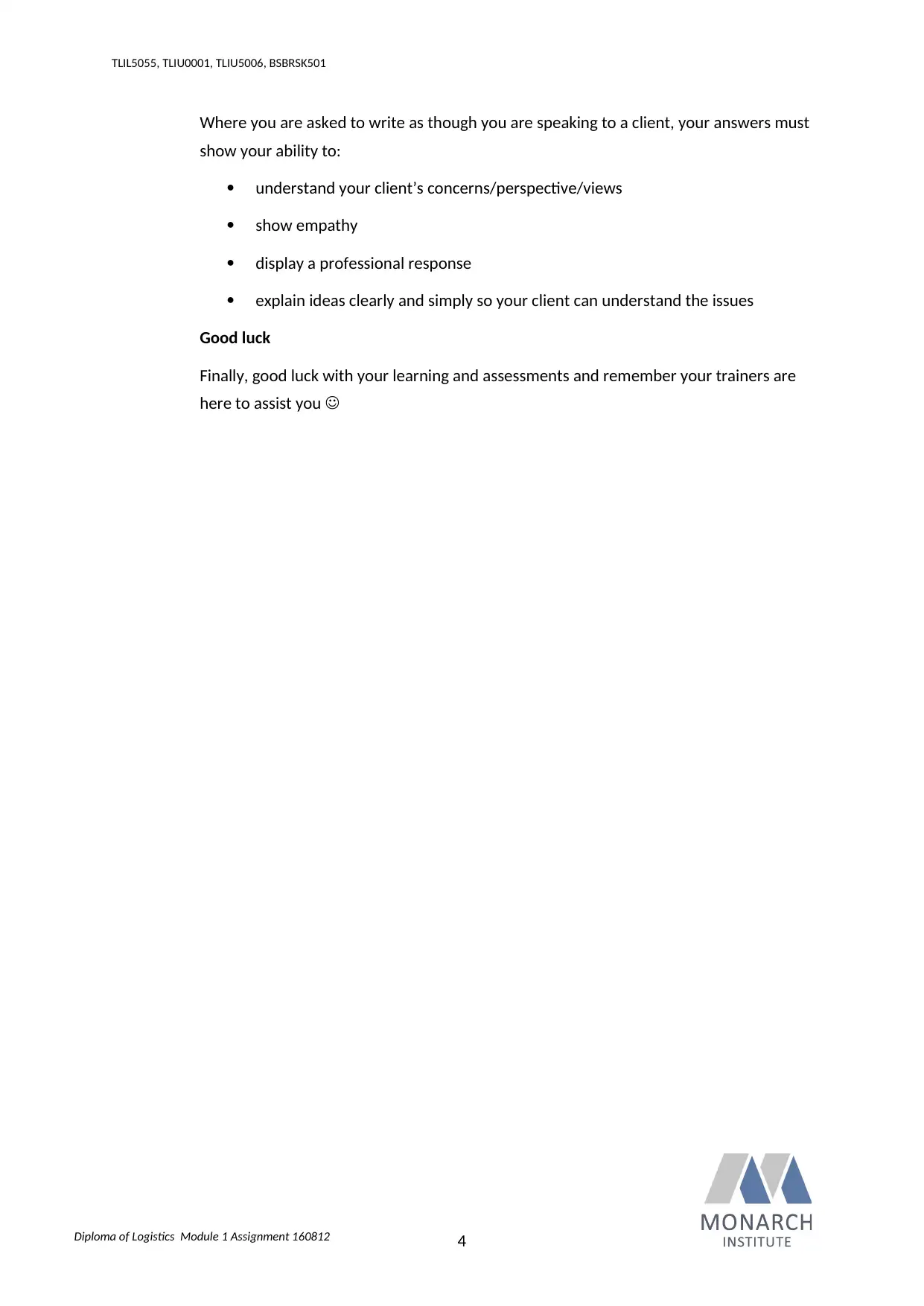
Diploma of Logistics Module 1 Assignment 160812
TLIL5055, TLIU0001, TLIU5006, BSBRSK501
Where you are asked to write as though you are speaking to a client, your answers must
show your ability to:
understand your client’s concerns/perspective/views
show empathy
display a professional response
explain ideas clearly and simply so your client can understand the issues
Good luck
Finally, good luck with your learning and assessments and remember your trainers are
here to assist you
4
TLIL5055, TLIU0001, TLIU5006, BSBRSK501
Where you are asked to write as though you are speaking to a client, your answers must
show your ability to:
understand your client’s concerns/perspective/views
show empathy
display a professional response
explain ideas clearly and simply so your client can understand the issues
Good luck
Finally, good luck with your learning and assessments and remember your trainers are
here to assist you
4
Secure Best Marks with AI Grader
Need help grading? Try our AI Grader for instant feedback on your assignments.

Diploma of Logistics Module 1 Assignment 160812
TLIL5055, TLIU0001, TLIU5006, BSBRSK501
Assessment Activity 1
Short answer questions
The enterprise, its logistics and supply chains
Activity instructions to candidates
This is an open book assessment activity.
You are required to read this assessment and answer all6questions that follow.
Please type your answers in the spaces provided.
Please ensure you have read “Important assessment information” at the front of this
assessment
Estimated time for completion of this assessment activity: 3 hours
These are short answer questions – requiring you to produce relevant diagrams with one or at most
two short paragraph explanations.
Operational
Question 1:
Explain the difference between logistics strategy and logistics operations.
Logistics strategy is planning supply chain and taking appropriate measures with ultimate goal of
providing satisfaction to customers. Strategy involves delivering product at right place in right time.
It aims at providing high service levels with most possible cost effective means. Flow of information
is tentative in this process. Logistics operations encompass the distribution systems consisting of
functions and procedures. Operations are associated with practical application of the strategies
devised to realize the strategic logistics management. Functional resources include bases,
workforces, assets, equipments, organizations and facilities. On the other hand, procedures include
functional processes that not only deliver resources at places where they are expected but also
utilizing those resources for logistics capabilities.
Logistics strategy strives to achieve the business objective through customer and production service
(CAPS), planning, purchasing and distribution. Operations include purchasing and distribution. While
strategy is a theoretical practice, operations define the practicality of proposed strategy. Logistic
operations associate tactical equipments to logistic capabilities for achieving operational goals and
objectives. Logistic managers identify the most cost effective methodology for distribution of
resources that are carried by the operation systems. Operations involve undergoing the physical
aspect of the supply chain management and implementing the strategy in most effective way.
5
TLIL5055, TLIU0001, TLIU5006, BSBRSK501
Assessment Activity 1
Short answer questions
The enterprise, its logistics and supply chains
Activity instructions to candidates
This is an open book assessment activity.
You are required to read this assessment and answer all6questions that follow.
Please type your answers in the spaces provided.
Please ensure you have read “Important assessment information” at the front of this
assessment
Estimated time for completion of this assessment activity: 3 hours
These are short answer questions – requiring you to produce relevant diagrams with one or at most
two short paragraph explanations.
Operational
Question 1:
Explain the difference between logistics strategy and logistics operations.
Logistics strategy is planning supply chain and taking appropriate measures with ultimate goal of
providing satisfaction to customers. Strategy involves delivering product at right place in right time.
It aims at providing high service levels with most possible cost effective means. Flow of information
is tentative in this process. Logistics operations encompass the distribution systems consisting of
functions and procedures. Operations are associated with practical application of the strategies
devised to realize the strategic logistics management. Functional resources include bases,
workforces, assets, equipments, organizations and facilities. On the other hand, procedures include
functional processes that not only deliver resources at places where they are expected but also
utilizing those resources for logistics capabilities.
Logistics strategy strives to achieve the business objective through customer and production service
(CAPS), planning, purchasing and distribution. Operations include purchasing and distribution. While
strategy is a theoretical practice, operations define the practicality of proposed strategy. Logistic
operations associate tactical equipments to logistic capabilities for achieving operational goals and
objectives. Logistic managers identify the most cost effective methodology for distribution of
resources that are carried by the operation systems. Operations involve undergoing the physical
aspect of the supply chain management and implementing the strategy in most effective way.
5
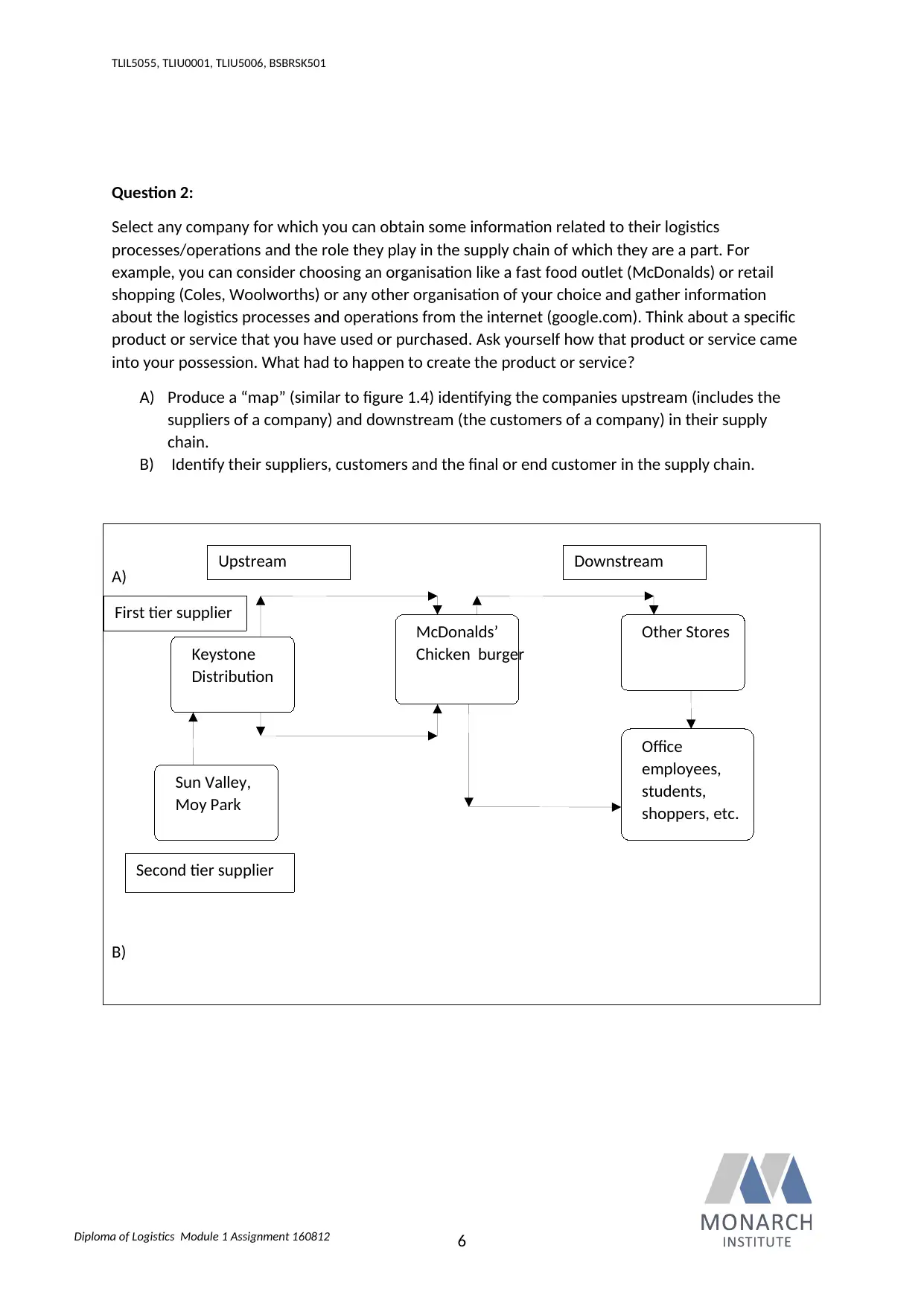
Diploma of Logistics Module 1 Assignment 160812
TLIL5055, TLIU0001, TLIU5006, BSBRSK501
Question 2:
Select any company for which you can obtain some information related to their logistics
processes/operations and the role they play in the supply chain of which they are a part. For
example, you can consider choosing an organisation like a fast food outlet (McDonalds) or retail
shopping (Coles, Woolworths) or any other organisation of your choice and gather information
about the logistics processes and operations from the internet (google.com). Think about a specific
product or service that you have used or purchased. Ask yourself how that product or service came
into your possession. What had to happen to create the product or service?
A) Produce a “map” (similar to figure 1.4) identifying the companies upstream (includes the
suppliers of a company) and downstream (the customers of a company) in their supply
chain.
B) Identify their suppliers, customers and the final or end customer in the supply chain.
A)
B)
6
McDonalds’
Chicken burger
Sun Valley,
Moy Park
Keystone
Distribution
Other Stores
Office
employees,
students,
shoppers, etc.
First tier supplier
Second tier supplier
Upstream Downstream
TLIL5055, TLIU0001, TLIU5006, BSBRSK501
Question 2:
Select any company for which you can obtain some information related to their logistics
processes/operations and the role they play in the supply chain of which they are a part. For
example, you can consider choosing an organisation like a fast food outlet (McDonalds) or retail
shopping (Coles, Woolworths) or any other organisation of your choice and gather information
about the logistics processes and operations from the internet (google.com). Think about a specific
product or service that you have used or purchased. Ask yourself how that product or service came
into your possession. What had to happen to create the product or service?
A) Produce a “map” (similar to figure 1.4) identifying the companies upstream (includes the
suppliers of a company) and downstream (the customers of a company) in their supply
chain.
B) Identify their suppliers, customers and the final or end customer in the supply chain.
A)
B)
6
McDonalds’
Chicken burger
Sun Valley,
Moy Park
Keystone
Distribution
Other Stores
Office
employees,
students,
shoppers, etc.
First tier supplier
Second tier supplier
Upstream Downstream

Diploma of Logistics Module 1 Assignment 160812
TLIL5055, TLIU0001, TLIU5006, BSBRSK501
Planning
Question 3:
A) Referring to the company you selected for question 2, what products or services does the
company produce?
McDonald’s Corporation is one of the leading fast food chains in the world catering to the eating
habits and needs of thousands of people all across the world. It specialises in varieties of bun
products. McDonald’s is famous for its Big Mac which forms the backbone of the corporation and
generates bigger revenue. Besides this, the food chain also produces and serves hamburgers,
cheeseburgers, chicken burgers, alternate chicken and fish products, French fries, McDouble, Bacon
McDouble and Double Cheeseburger. Among special chicken products, they serve Chicken
McNuggets, McArabia, Chicken Fajita, etc. McDonald’s also serving its special desserts, milkshakes
and ice creams. Along with selling food items McDonald’s also sell extra value meal consisting,
burger fries, and soft drinks. Their services include selling up and suggestive selling where order is
altered at the last moment or asked for adding some extra items in made orders respectively.
B) Now position the company of your choice with one of their products or services in a matrix
of process and product using a framework (like Figure 1.10 or Figure 1.11). Produce a matrix
similar to these figures for the company you selected in the appropriate position.
7
TLIL5055, TLIU0001, TLIU5006, BSBRSK501
Planning
Question 3:
A) Referring to the company you selected for question 2, what products or services does the
company produce?
McDonald’s Corporation is one of the leading fast food chains in the world catering to the eating
habits and needs of thousands of people all across the world. It specialises in varieties of bun
products. McDonald’s is famous for its Big Mac which forms the backbone of the corporation and
generates bigger revenue. Besides this, the food chain also produces and serves hamburgers,
cheeseburgers, chicken burgers, alternate chicken and fish products, French fries, McDouble, Bacon
McDouble and Double Cheeseburger. Among special chicken products, they serve Chicken
McNuggets, McArabia, Chicken Fajita, etc. McDonald’s also serving its special desserts, milkshakes
and ice creams. Along with selling food items McDonald’s also sell extra value meal consisting,
burger fries, and soft drinks. Their services include selling up and suggestive selling where order is
altered at the last moment or asked for adding some extra items in made orders respectively.
B) Now position the company of your choice with one of their products or services in a matrix
of process and product using a framework (like Figure 1.10 or Figure 1.11). Produce a matrix
similar to these figures for the company you selected in the appropriate position.
7
Paraphrase This Document
Need a fresh take? Get an instant paraphrase of this document with our AI Paraphraser
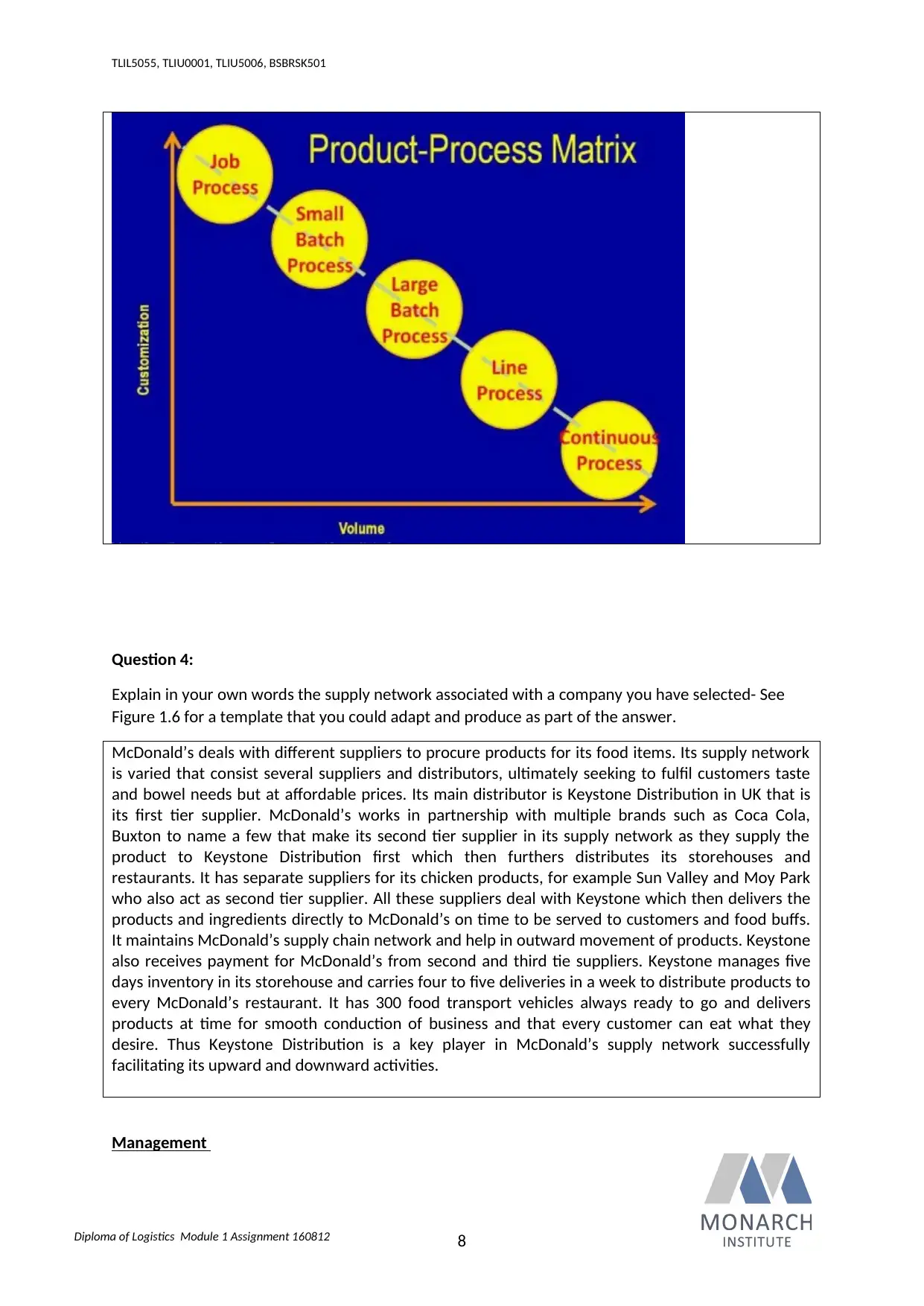
Diploma of Logistics Module 1 Assignment 160812
TLIL5055, TLIU0001, TLIU5006, BSBRSK501
Question 4:
Explain in your own words the supply network associated with a company you have selected- See
Figure 1.6 for a template that you could adapt and produce as part of the answer.
McDonald’s deals with different suppliers to procure products for its food items. Its supply network
is varied that consist several suppliers and distributors, ultimately seeking to fulfil customers taste
and bowel needs but at affordable prices. Its main distributor is Keystone Distribution in UK that is
its first tier supplier. McDonald’s works in partnership with multiple brands such as Coca Cola,
Buxton to name a few that make its second tier supplier in its supply network as they supply the
product to Keystone Distribution first which then furthers distributes its storehouses and
restaurants. It has separate suppliers for its chicken products, for example Sun Valley and Moy Park
who also act as second tier supplier. All these suppliers deal with Keystone which then delivers the
products and ingredients directly to McDonald’s on time to be served to customers and food buffs.
It maintains McDonald’s supply chain network and help in outward movement of products. Keystone
also receives payment for McDonald’s from second and third tie suppliers. Keystone manages five
days inventory in its storehouse and carries four to five deliveries in a week to distribute products to
every McDonald’s restaurant. It has 300 food transport vehicles always ready to go and delivers
products at time for smooth conduction of business and that every customer can eat what they
desire. Thus Keystone Distribution is a key player in McDonald’s supply network successfully
facilitating its upward and downward activities.
Management
8
TLIL5055, TLIU0001, TLIU5006, BSBRSK501
Question 4:
Explain in your own words the supply network associated with a company you have selected- See
Figure 1.6 for a template that you could adapt and produce as part of the answer.
McDonald’s deals with different suppliers to procure products for its food items. Its supply network
is varied that consist several suppliers and distributors, ultimately seeking to fulfil customers taste
and bowel needs but at affordable prices. Its main distributor is Keystone Distribution in UK that is
its first tier supplier. McDonald’s works in partnership with multiple brands such as Coca Cola,
Buxton to name a few that make its second tier supplier in its supply network as they supply the
product to Keystone Distribution first which then furthers distributes its storehouses and
restaurants. It has separate suppliers for its chicken products, for example Sun Valley and Moy Park
who also act as second tier supplier. All these suppliers deal with Keystone which then delivers the
products and ingredients directly to McDonald’s on time to be served to customers and food buffs.
It maintains McDonald’s supply chain network and help in outward movement of products. Keystone
also receives payment for McDonald’s from second and third tie suppliers. Keystone manages five
days inventory in its storehouse and carries four to five deliveries in a week to distribute products to
every McDonald’s restaurant. It has 300 food transport vehicles always ready to go and delivers
products at time for smooth conduction of business and that every customer can eat what they
desire. Thus Keystone Distribution is a key player in McDonald’s supply network successfully
facilitating its upward and downward activities.
Management
8
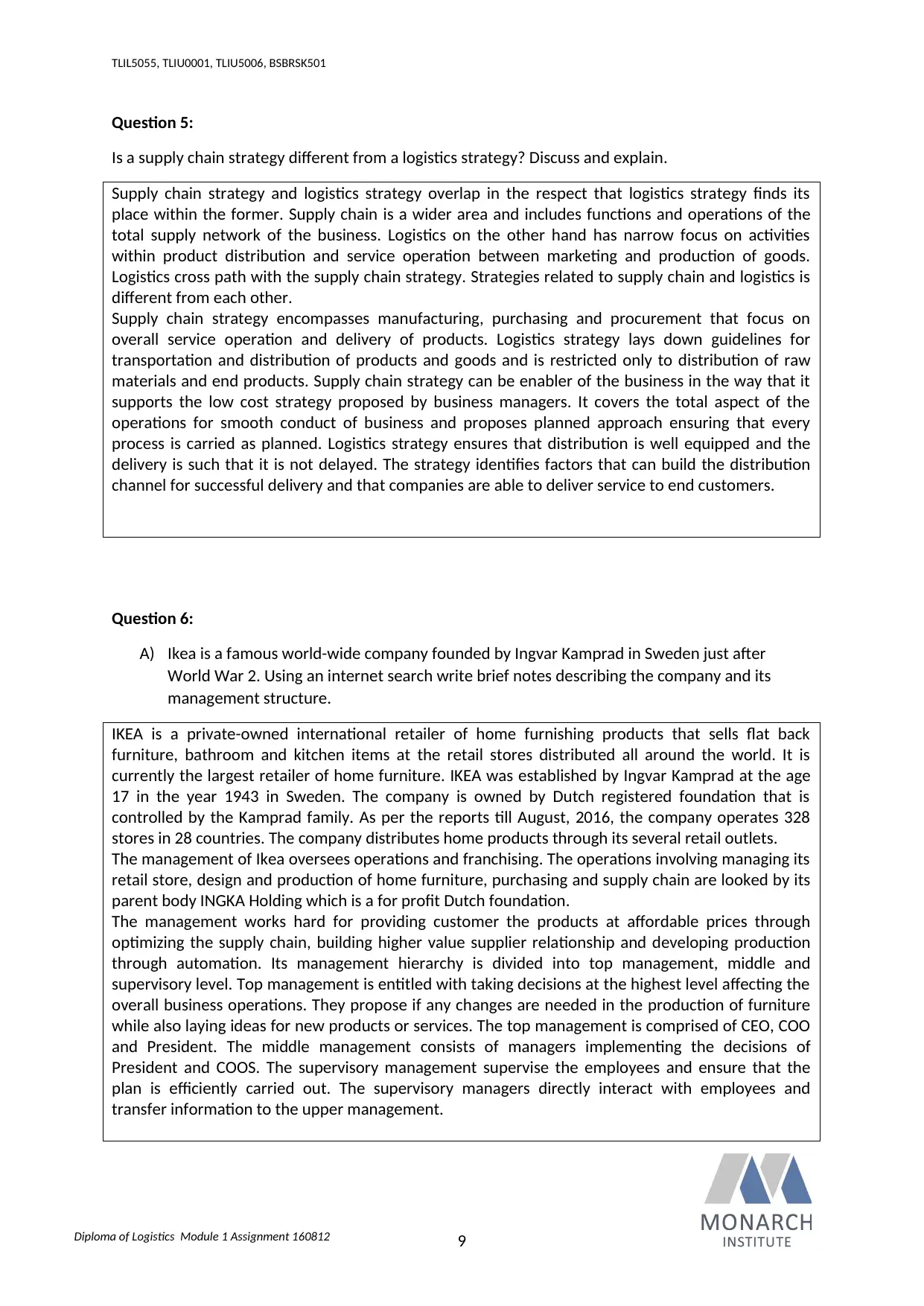
Diploma of Logistics Module 1 Assignment 160812
TLIL5055, TLIU0001, TLIU5006, BSBRSK501
Question 5:
Is a supply chain strategy different from a logistics strategy? Discuss and explain.
Supply chain strategy and logistics strategy overlap in the respect that logistics strategy finds its
place within the former. Supply chain is a wider area and includes functions and operations of the
total supply network of the business. Logistics on the other hand has narrow focus on activities
within product distribution and service operation between marketing and production of goods.
Logistics cross path with the supply chain strategy. Strategies related to supply chain and logistics is
different from each other.
Supply chain strategy encompasses manufacturing, purchasing and procurement that focus on
overall service operation and delivery of products. Logistics strategy lays down guidelines for
transportation and distribution of products and goods and is restricted only to distribution of raw
materials and end products. Supply chain strategy can be enabler of the business in the way that it
supports the low cost strategy proposed by business managers. It covers the total aspect of the
operations for smooth conduct of business and proposes planned approach ensuring that every
process is carried as planned. Logistics strategy ensures that distribution is well equipped and the
delivery is such that it is not delayed. The strategy identifies factors that can build the distribution
channel for successful delivery and that companies are able to deliver service to end customers.
Question 6:
A) Ikea is a famous world-wide company founded by Ingvar Kamprad in Sweden just after
World War 2. Using an internet search write brief notes describing the company and its
management structure.
IKEA is a private-owned international retailer of home furnishing products that sells flat back
furniture, bathroom and kitchen items at the retail stores distributed all around the world. It is
currently the largest retailer of home furniture. IKEA was established by Ingvar Kamprad at the age
17 in the year 1943 in Sweden. The company is owned by Dutch registered foundation that is
controlled by the Kamprad family. As per the reports till August, 2016, the company operates 328
stores in 28 countries. The company distributes home products through its several retail outlets.
The management of Ikea oversees operations and franchising. The operations involving managing its
retail store, design and production of home furniture, purchasing and supply chain are looked by its
parent body INGKA Holding which is a for profit Dutch foundation.
The management works hard for providing customer the products at affordable prices through
optimizing the supply chain, building higher value supplier relationship and developing production
through automation. Its management hierarchy is divided into top management, middle and
supervisory level. Top management is entitled with taking decisions at the highest level affecting the
overall business operations. They propose if any changes are needed in the production of furniture
while also laying ideas for new products or services. The top management is comprised of CEO, COO
and President. The middle management consists of managers implementing the decisions of
President and COOS. The supervisory management supervise the employees and ensure that the
plan is efficiently carried out. The supervisory managers directly interact with employees and
transfer information to the upper management.
9
TLIL5055, TLIU0001, TLIU5006, BSBRSK501
Question 5:
Is a supply chain strategy different from a logistics strategy? Discuss and explain.
Supply chain strategy and logistics strategy overlap in the respect that logistics strategy finds its
place within the former. Supply chain is a wider area and includes functions and operations of the
total supply network of the business. Logistics on the other hand has narrow focus on activities
within product distribution and service operation between marketing and production of goods.
Logistics cross path with the supply chain strategy. Strategies related to supply chain and logistics is
different from each other.
Supply chain strategy encompasses manufacturing, purchasing and procurement that focus on
overall service operation and delivery of products. Logistics strategy lays down guidelines for
transportation and distribution of products and goods and is restricted only to distribution of raw
materials and end products. Supply chain strategy can be enabler of the business in the way that it
supports the low cost strategy proposed by business managers. It covers the total aspect of the
operations for smooth conduct of business and proposes planned approach ensuring that every
process is carried as planned. Logistics strategy ensures that distribution is well equipped and the
delivery is such that it is not delayed. The strategy identifies factors that can build the distribution
channel for successful delivery and that companies are able to deliver service to end customers.
Question 6:
A) Ikea is a famous world-wide company founded by Ingvar Kamprad in Sweden just after
World War 2. Using an internet search write brief notes describing the company and its
management structure.
IKEA is a private-owned international retailer of home furnishing products that sells flat back
furniture, bathroom and kitchen items at the retail stores distributed all around the world. It is
currently the largest retailer of home furniture. IKEA was established by Ingvar Kamprad at the age
17 in the year 1943 in Sweden. The company is owned by Dutch registered foundation that is
controlled by the Kamprad family. As per the reports till August, 2016, the company operates 328
stores in 28 countries. The company distributes home products through its several retail outlets.
The management of Ikea oversees operations and franchising. The operations involving managing its
retail store, design and production of home furniture, purchasing and supply chain are looked by its
parent body INGKA Holding which is a for profit Dutch foundation.
The management works hard for providing customer the products at affordable prices through
optimizing the supply chain, building higher value supplier relationship and developing production
through automation. Its management hierarchy is divided into top management, middle and
supervisory level. Top management is entitled with taking decisions at the highest level affecting the
overall business operations. They propose if any changes are needed in the production of furniture
while also laying ideas for new products or services. The top management is comprised of CEO, COO
and President. The middle management consists of managers implementing the decisions of
President and COOS. The supervisory management supervise the employees and ensure that the
plan is efficiently carried out. The supervisory managers directly interact with employees and
transfer information to the upper management.
9
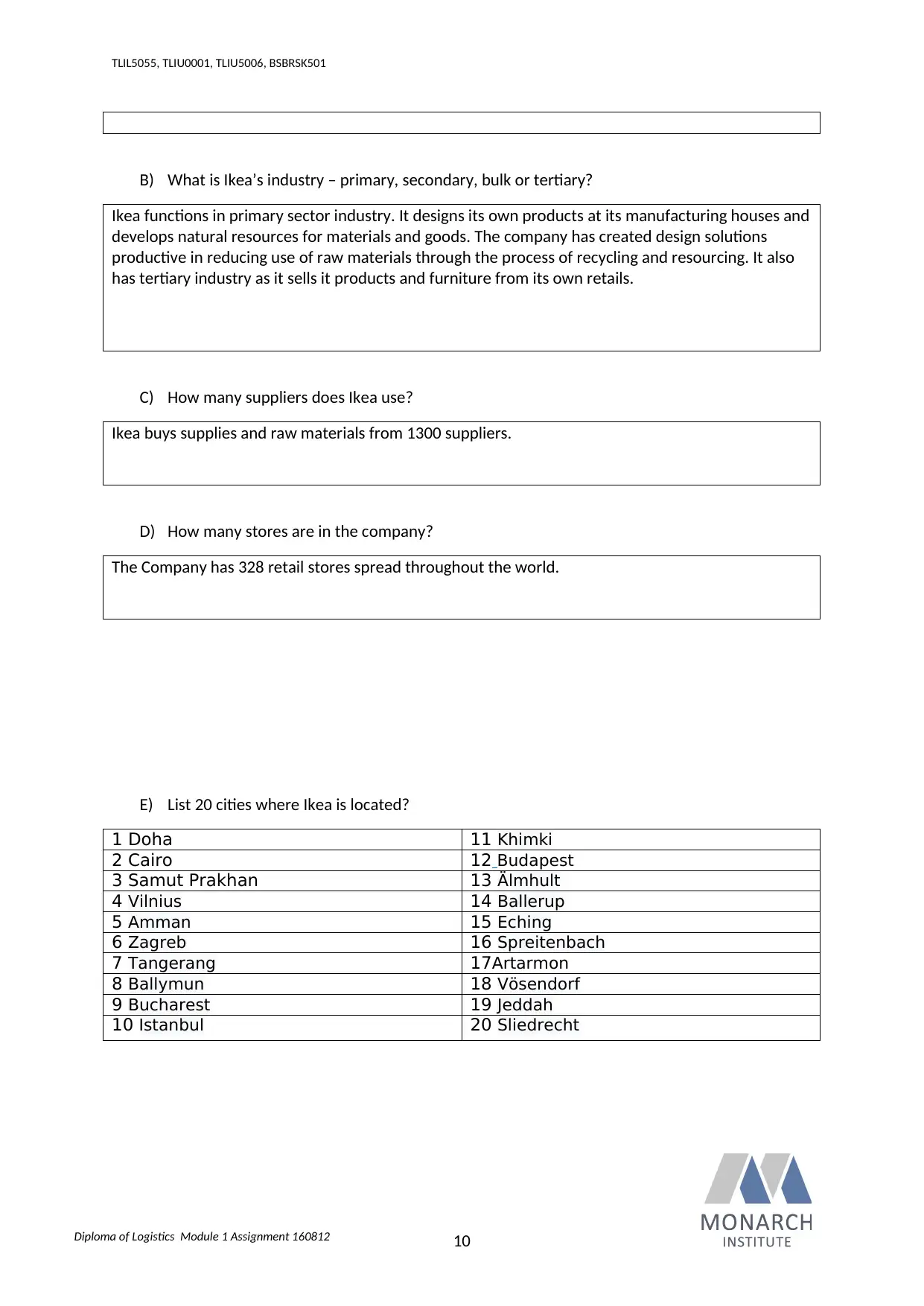
Diploma of Logistics Module 1 Assignment 160812
TLIL5055, TLIU0001, TLIU5006, BSBRSK501
B) What is Ikea’s industry – primary, secondary, bulk or tertiary?
Ikea functions in primary sector industry. It designs its own products at its manufacturing houses and
develops natural resources for materials and goods. The company has created design solutions
productive in reducing use of raw materials through the process of recycling and resourcing. It also
has tertiary industry as it sells it products and furniture from its own retails.
C) How many suppliers does Ikea use?
Ikea buys supplies and raw materials from 1300 suppliers.
D) How many stores are in the company?
The Company has 328 retail stores spread throughout the world.
E) List 20 cities where Ikea is located?
1 Doha 11 Khimki
2 Cairo 12 Budapest
3 Samut Prakhan 13 Älmhult
4 Vilnius 14 Ballerup
5 Amman 15 Eching
6 Zagreb 16 Spreitenbach
7 Tangerang 17Artarmon
8 Ballymun 18 Vösendorf
9 Bucharest 19 Jeddah
10 Istanbul 20 Sliedrecht
10
TLIL5055, TLIU0001, TLIU5006, BSBRSK501
B) What is Ikea’s industry – primary, secondary, bulk or tertiary?
Ikea functions in primary sector industry. It designs its own products at its manufacturing houses and
develops natural resources for materials and goods. The company has created design solutions
productive in reducing use of raw materials through the process of recycling and resourcing. It also
has tertiary industry as it sells it products and furniture from its own retails.
C) How many suppliers does Ikea use?
Ikea buys supplies and raw materials from 1300 suppliers.
D) How many stores are in the company?
The Company has 328 retail stores spread throughout the world.
E) List 20 cities where Ikea is located?
1 Doha 11 Khimki
2 Cairo 12 Budapest
3 Samut Prakhan 13 Älmhult
4 Vilnius 14 Ballerup
5 Amman 15 Eching
6 Zagreb 16 Spreitenbach
7 Tangerang 17Artarmon
8 Ballymun 18 Vösendorf
9 Bucharest 19 Jeddah
10 Istanbul 20 Sliedrecht
10
Secure Best Marks with AI Grader
Need help grading? Try our AI Grader for instant feedback on your assignments.

Diploma of Logistics Module 1 Assignment 160812
TLIL5055, TLIU0001, TLIU5006, BSBRSK501
Assessment Activity 2
Short answer questions
Business planning, risk and sustainability
Activity instructions to candidates
This is an open book assessment activity.
You are required to read this assessment and answer all 7questions that follow.
Please type your answers in the spaces provided.
Please ensure you have read “Important assessment information” at the front of this
assessment
Estimated time for completion of this assessment activity: 1-2 hours
11
TLIL5055, TLIU0001, TLIU5006, BSBRSK501
Assessment Activity 2
Short answer questions
Business planning, risk and sustainability
Activity instructions to candidates
This is an open book assessment activity.
You are required to read this assessment and answer all 7questions that follow.
Please type your answers in the spaces provided.
Please ensure you have read “Important assessment information” at the front of this
assessment
Estimated time for completion of this assessment activity: 1-2 hours
11
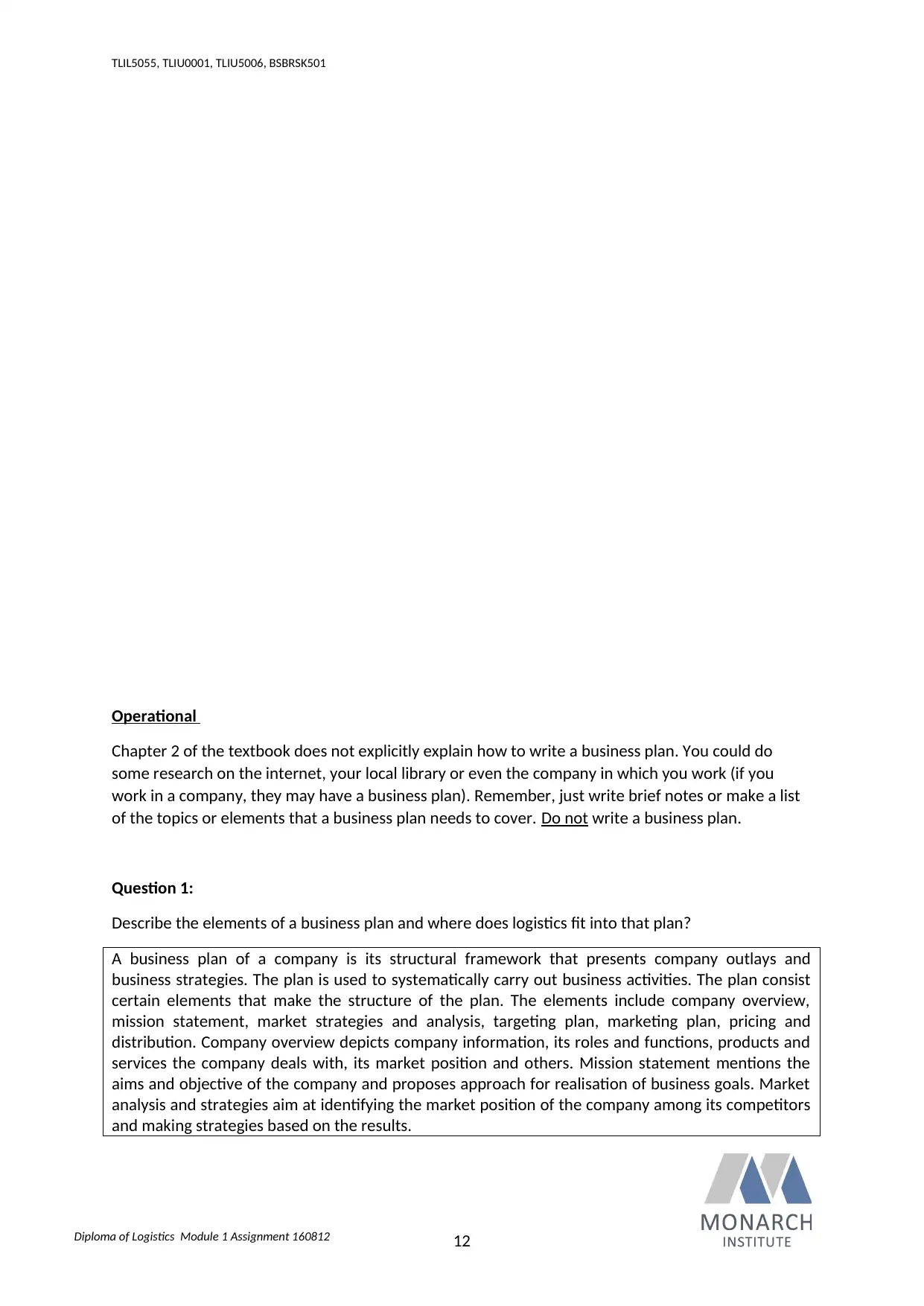
Diploma of Logistics Module 1 Assignment 160812
TLIL5055, TLIU0001, TLIU5006, BSBRSK501
Operational
Chapter 2 of the textbook does not explicitly explain how to write a business plan. You could do
some research on the internet, your local library or even the company in which you work (if you
work in a company, they may have a business plan). Remember, just write brief notes or make a list
of the topics or elements that a business plan needs to cover. Do not write a business plan.
Question 1:
Describe the elements of a business plan and where does logistics fit into that plan?
A business plan of a company is its structural framework that presents company outlays and
business strategies. The plan is used to systematically carry out business activities. The plan consist
certain elements that make the structure of the plan. The elements include company overview,
mission statement, market strategies and analysis, targeting plan, marketing plan, pricing and
distribution. Company overview depicts company information, its roles and functions, products and
services the company deals with, its market position and others. Mission statement mentions the
aims and objective of the company and proposes approach for realisation of business goals. Market
analysis and strategies aim at identifying the market position of the company among its competitors
and making strategies based on the results.
12
TLIL5055, TLIU0001, TLIU5006, BSBRSK501
Operational
Chapter 2 of the textbook does not explicitly explain how to write a business plan. You could do
some research on the internet, your local library or even the company in which you work (if you
work in a company, they may have a business plan). Remember, just write brief notes or make a list
of the topics or elements that a business plan needs to cover. Do not write a business plan.
Question 1:
Describe the elements of a business plan and where does logistics fit into that plan?
A business plan of a company is its structural framework that presents company outlays and
business strategies. The plan is used to systematically carry out business activities. The plan consist
certain elements that make the structure of the plan. The elements include company overview,
mission statement, market strategies and analysis, targeting plan, marketing plan, pricing and
distribution. Company overview depicts company information, its roles and functions, products and
services the company deals with, its market position and others. Mission statement mentions the
aims and objective of the company and proposes approach for realisation of business goals. Market
analysis and strategies aim at identifying the market position of the company among its competitors
and making strategies based on the results.
12

Diploma of Logistics Module 1 Assignment 160812
TLIL5055, TLIU0001, TLIU5006, BSBRSK501
Logistics comes at the last stage of the plan as it will be undertaken only when previous elements of
the plan are successfully realised and implemented. It is responsible for successful inward and
outward distribution of service. So only when that service is identified and initiated logistics can go
with its tasks. Unfulfilled or incomplete implementation of other elements can affect the logistics
and though being effective in operation and getting results, logistics may fail to achieve the desired
objective.
Question 2:
Research the Australian business Visy Industries. (http://www.visy.com.au/about/visy/#header-
title). Describe the main factors or elements of the company’s business model.
Visy’s is a privately owned paper, packaging and recycling industry established in Melbourne,
Australia. It employs more than 5500 staffs across New Zealand, Australia, Vietnam and Thailand.
Visy’s business model seeks to become a leading provider of paper recycling and packaging products
through fostering innovation and sustainable solutions for greater and efficient returns. Its business
model identifies several factors that can build its strategies and foster business operations. Main
elements of Visy’s business model include customer relationship. They plan to collaborate with their
customers in order to increase their profit through smart solutions. Personal assistance from service
representatives facilitates both automated and self service.
Element of leading change ensure that they enhance their leadership positions and accept changes
in environmental and sustainable initiatives. Strategic partnership facilitates better work culture and
builds closed and collaborative team of skilled people. Developing strong value proportion allow the
management of Visy’s to build onto their strengths and lay foundation for future business growth
and development. Through this Visy’s can correlate their own workforce effectiveness with their
competitors and determine value of their position in the market. Room for innovation encourage
new strategies ideas and business thoughts in technology upgradation initiatives.
Planning
Question 3:
Explain how a company can achieve a competitive advantage. To begin, examine Figure 2.8 of the
text book.
13
TLIL5055, TLIU0001, TLIU5006, BSBRSK501
Logistics comes at the last stage of the plan as it will be undertaken only when previous elements of
the plan are successfully realised and implemented. It is responsible for successful inward and
outward distribution of service. So only when that service is identified and initiated logistics can go
with its tasks. Unfulfilled or incomplete implementation of other elements can affect the logistics
and though being effective in operation and getting results, logistics may fail to achieve the desired
objective.
Question 2:
Research the Australian business Visy Industries. (http://www.visy.com.au/about/visy/#header-
title). Describe the main factors or elements of the company’s business model.
Visy’s is a privately owned paper, packaging and recycling industry established in Melbourne,
Australia. It employs more than 5500 staffs across New Zealand, Australia, Vietnam and Thailand.
Visy’s business model seeks to become a leading provider of paper recycling and packaging products
through fostering innovation and sustainable solutions for greater and efficient returns. Its business
model identifies several factors that can build its strategies and foster business operations. Main
elements of Visy’s business model include customer relationship. They plan to collaborate with their
customers in order to increase their profit through smart solutions. Personal assistance from service
representatives facilitates both automated and self service.
Element of leading change ensure that they enhance their leadership positions and accept changes
in environmental and sustainable initiatives. Strategic partnership facilitates better work culture and
builds closed and collaborative team of skilled people. Developing strong value proportion allow the
management of Visy’s to build onto their strengths and lay foundation for future business growth
and development. Through this Visy’s can correlate their own workforce effectiveness with their
competitors and determine value of their position in the market. Room for innovation encourage
new strategies ideas and business thoughts in technology upgradation initiatives.
Planning
Question 3:
Explain how a company can achieve a competitive advantage. To begin, examine Figure 2.8 of the
text book.
13
Paraphrase This Document
Need a fresh take? Get an instant paraphrase of this document with our AI Paraphraser

Diploma of Logistics Module 1 Assignment 160812
TLIL5055, TLIU0001, TLIU5006, BSBRSK501
Company advantage can facilitate business growth by offering grater valued products and services to
customers compared to competitors by the means of reduced price or additional benefits with the
acquired services. For the purpose of gaining competitive advantage company need to first adopt
business strategies that can give it an edge over its competitors. The first step involves
understanding the customer. Company need to identify the demographics of the consumer base
based on who are the customers and what is the age group of most proficient customers. Then is
examining the strength of business. What are the factors that differentiate won business with the
rest and identify what is it that attracts customers than other products of services. It helps in
identifying areas in which the company can directs its focus on, that company can take advantage of.
It is always better to play on our strengths. Then the company needs to make analysis of the
competitors to identify fields it may lag behind them and needs immediate restructuring. Company
can reduce cost to ensure that customers get same service at lower prices than at its competitors.
This also demands for focusing on better service quality and delivery. When the company can
provide better service in time and with better benefits, customers would prefer to visit it than
switching to its competitors.
Question 4:
What role does logistics play in helping a company achieve a competitive advantage?
Competitive advantage can be achieved through reduction of business cost and improved service
delivery thus creating opportunities for increased business sales and growth. Service delivery and
distribution is maintained and controlled by logistics. Logistics thus have a helping hand in
integrating competitive advantage in a company. Through proper logistics planning and
implementation, company can minimize its operational cost, giving an economy advantage to it over
its competitors. The company would save funds and utilize in other development measures. Logistics
provide defined mission and philosophy, creative strategies and stronger supply network. It is
customer focused and fosters competitive and coordinated initiatives that build distinctive
competencies not easily duplicated.
Company’s own stronger distribution channel ensures that it delivers fast and in time than its
competitors, thus allowing it to serve customer before any other. In time supply encourage
customers to avail services where there is no delay and the service provide care for them. Thus best
practice logistics supply integrates user expectations, business requirements and purchase flow of
materials and services. It satisfies customers by providing better valued services thus rewarding
shareholders and business organizations with greater profitability and returns. Logistics also ensure
delivery of quality products and maintaining the product effectiveness. Thus logistics does have
small but definitive role in achieving competitive advantage.
Management
Question 5:
Explain the elements of a logistics strategy.
Logistics strategy focuses on planning and methodology of the operations for successful distribution
of products or services. It identifies certain elements that build practicality and effectiveness of the
14
TLIL5055, TLIU0001, TLIU5006, BSBRSK501
Company advantage can facilitate business growth by offering grater valued products and services to
customers compared to competitors by the means of reduced price or additional benefits with the
acquired services. For the purpose of gaining competitive advantage company need to first adopt
business strategies that can give it an edge over its competitors. The first step involves
understanding the customer. Company need to identify the demographics of the consumer base
based on who are the customers and what is the age group of most proficient customers. Then is
examining the strength of business. What are the factors that differentiate won business with the
rest and identify what is it that attracts customers than other products of services. It helps in
identifying areas in which the company can directs its focus on, that company can take advantage of.
It is always better to play on our strengths. Then the company needs to make analysis of the
competitors to identify fields it may lag behind them and needs immediate restructuring. Company
can reduce cost to ensure that customers get same service at lower prices than at its competitors.
This also demands for focusing on better service quality and delivery. When the company can
provide better service in time and with better benefits, customers would prefer to visit it than
switching to its competitors.
Question 4:
What role does logistics play in helping a company achieve a competitive advantage?
Competitive advantage can be achieved through reduction of business cost and improved service
delivery thus creating opportunities for increased business sales and growth. Service delivery and
distribution is maintained and controlled by logistics. Logistics thus have a helping hand in
integrating competitive advantage in a company. Through proper logistics planning and
implementation, company can minimize its operational cost, giving an economy advantage to it over
its competitors. The company would save funds and utilize in other development measures. Logistics
provide defined mission and philosophy, creative strategies and stronger supply network. It is
customer focused and fosters competitive and coordinated initiatives that build distinctive
competencies not easily duplicated.
Company’s own stronger distribution channel ensures that it delivers fast and in time than its
competitors, thus allowing it to serve customer before any other. In time supply encourage
customers to avail services where there is no delay and the service provide care for them. Thus best
practice logistics supply integrates user expectations, business requirements and purchase flow of
materials and services. It satisfies customers by providing better valued services thus rewarding
shareholders and business organizations with greater profitability and returns. Logistics also ensure
delivery of quality products and maintaining the product effectiveness. Thus logistics does have
small but definitive role in achieving competitive advantage.
Management
Question 5:
Explain the elements of a logistics strategy.
Logistics strategy focuses on planning and methodology of the operations for successful distribution
of products or services. It identifies certain elements that build practicality and effectiveness of the
14
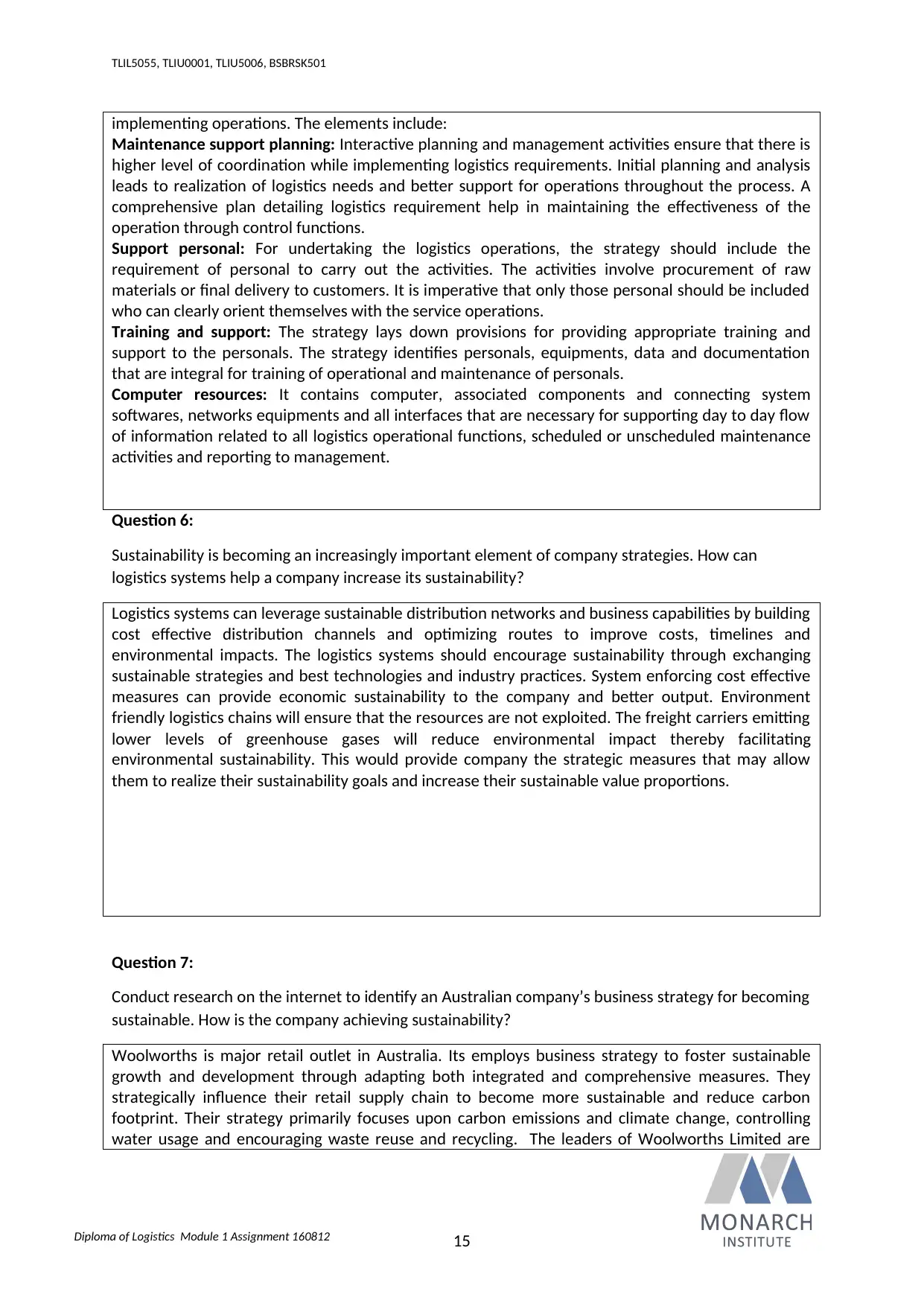
Diploma of Logistics Module 1 Assignment 160812
TLIL5055, TLIU0001, TLIU5006, BSBRSK501
implementing operations. The elements include:
Maintenance support planning: Interactive planning and management activities ensure that there is
higher level of coordination while implementing logistics requirements. Initial planning and analysis
leads to realization of logistics needs and better support for operations throughout the process. A
comprehensive plan detailing logistics requirement help in maintaining the effectiveness of the
operation through control functions.
Support personal: For undertaking the logistics operations, the strategy should include the
requirement of personal to carry out the activities. The activities involve procurement of raw
materials or final delivery to customers. It is imperative that only those personal should be included
who can clearly orient themselves with the service operations.
Training and support: The strategy lays down provisions for providing appropriate training and
support to the personals. The strategy identifies personals, equipments, data and documentation
that are integral for training of operational and maintenance of personals.
Computer resources: It contains computer, associated components and connecting system
softwares, networks equipments and all interfaces that are necessary for supporting day to day flow
of information related to all logistics operational functions, scheduled or unscheduled maintenance
activities and reporting to management.
Question 6:
Sustainability is becoming an increasingly important element of company strategies. How can
logistics systems help a company increase its sustainability?
Logistics systems can leverage sustainable distribution networks and business capabilities by building
cost effective distribution channels and optimizing routes to improve costs, timelines and
environmental impacts. The logistics systems should encourage sustainability through exchanging
sustainable strategies and best technologies and industry practices. System enforcing cost effective
measures can provide economic sustainability to the company and better output. Environment
friendly logistics chains will ensure that the resources are not exploited. The freight carriers emitting
lower levels of greenhouse gases will reduce environmental impact thereby facilitating
environmental sustainability. This would provide company the strategic measures that may allow
them to realize their sustainability goals and increase their sustainable value proportions.
Question 7:
Conduct research on the internet to identify an Australian company’s business strategy for becoming
sustainable. How is the company achieving sustainability?
Woolworths is major retail outlet in Australia. Its employs business strategy to foster sustainable
growth and development through adapting both integrated and comprehensive measures. They
strategically influence their retail supply chain to become more sustainable and reduce carbon
footprint. Their strategy primarily focuses upon carbon emissions and climate change, controlling
water usage and encouraging waste reuse and recycling. The leaders of Woolworths Limited are
15
TLIL5055, TLIU0001, TLIU5006, BSBRSK501
implementing operations. The elements include:
Maintenance support planning: Interactive planning and management activities ensure that there is
higher level of coordination while implementing logistics requirements. Initial planning and analysis
leads to realization of logistics needs and better support for operations throughout the process. A
comprehensive plan detailing logistics requirement help in maintaining the effectiveness of the
operation through control functions.
Support personal: For undertaking the logistics operations, the strategy should include the
requirement of personal to carry out the activities. The activities involve procurement of raw
materials or final delivery to customers. It is imperative that only those personal should be included
who can clearly orient themselves with the service operations.
Training and support: The strategy lays down provisions for providing appropriate training and
support to the personals. The strategy identifies personals, equipments, data and documentation
that are integral for training of operational and maintenance of personals.
Computer resources: It contains computer, associated components and connecting system
softwares, networks equipments and all interfaces that are necessary for supporting day to day flow
of information related to all logistics operational functions, scheduled or unscheduled maintenance
activities and reporting to management.
Question 6:
Sustainability is becoming an increasingly important element of company strategies. How can
logistics systems help a company increase its sustainability?
Logistics systems can leverage sustainable distribution networks and business capabilities by building
cost effective distribution channels and optimizing routes to improve costs, timelines and
environmental impacts. The logistics systems should encourage sustainability through exchanging
sustainable strategies and best technologies and industry practices. System enforcing cost effective
measures can provide economic sustainability to the company and better output. Environment
friendly logistics chains will ensure that the resources are not exploited. The freight carriers emitting
lower levels of greenhouse gases will reduce environmental impact thereby facilitating
environmental sustainability. This would provide company the strategic measures that may allow
them to realize their sustainability goals and increase their sustainable value proportions.
Question 7:
Conduct research on the internet to identify an Australian company’s business strategy for becoming
sustainable. How is the company achieving sustainability?
Woolworths is major retail outlet in Australia. Its employs business strategy to foster sustainable
growth and development through adapting both integrated and comprehensive measures. They
strategically influence their retail supply chain to become more sustainable and reduce carbon
footprint. Their strategy primarily focuses upon carbon emissions and climate change, controlling
water usage and encouraging waste reuse and recycling. The leaders of Woolworths Limited are
15
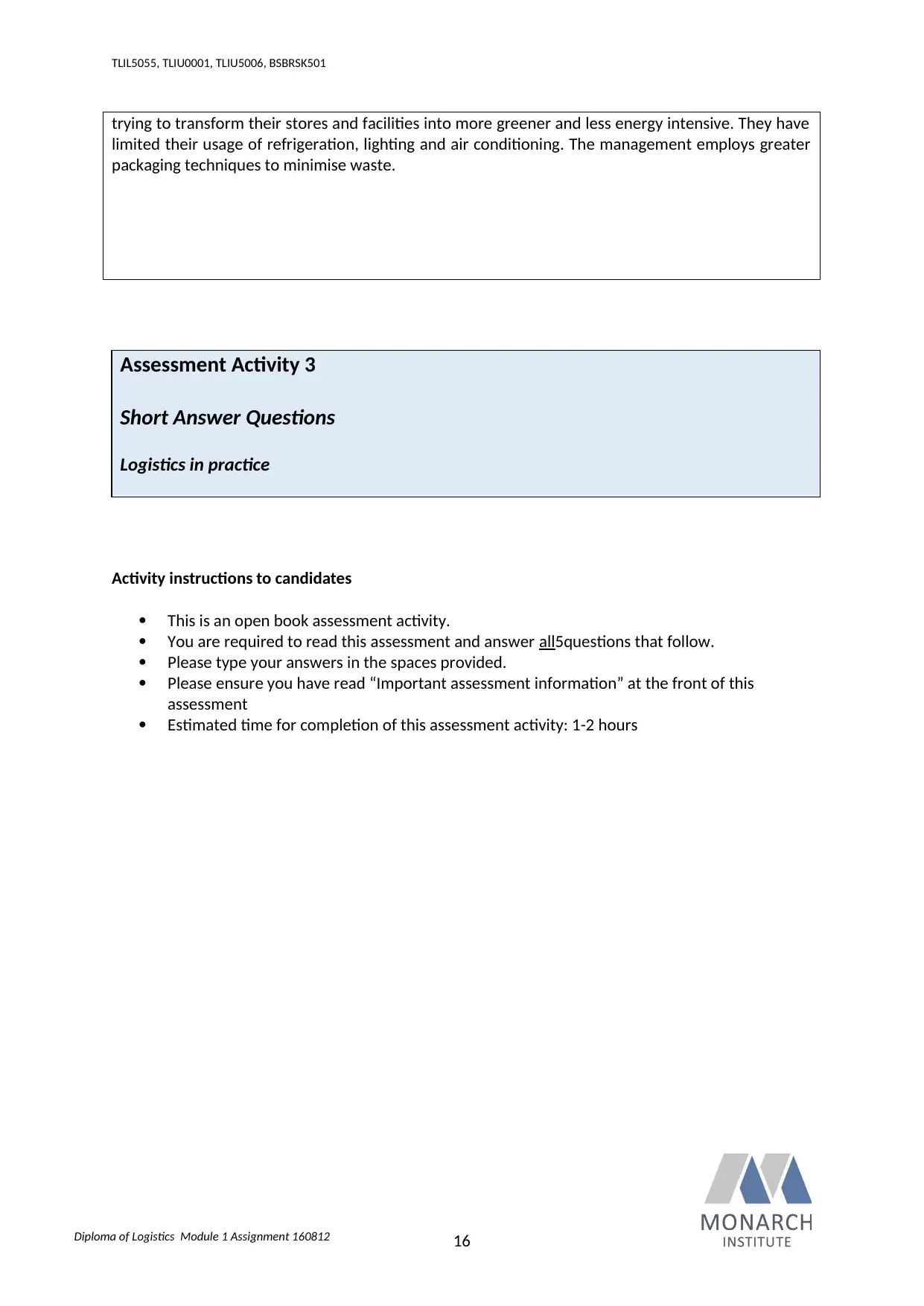
Diploma of Logistics Module 1 Assignment 160812
TLIL5055, TLIU0001, TLIU5006, BSBRSK501
trying to transform their stores and facilities into more greener and less energy intensive. They have
limited their usage of refrigeration, lighting and air conditioning. The management employs greater
packaging techniques to minimise waste.
Assessment Activity 3
Short Answer Questions
Logistics in practice
Activity instructions to candidates
This is an open book assessment activity.
You are required to read this assessment and answer all5questions that follow.
Please type your answers in the spaces provided.
Please ensure you have read “Important assessment information” at the front of this
assessment
Estimated time for completion of this assessment activity: 1-2 hours
16
TLIL5055, TLIU0001, TLIU5006, BSBRSK501
trying to transform their stores and facilities into more greener and less energy intensive. They have
limited their usage of refrigeration, lighting and air conditioning. The management employs greater
packaging techniques to minimise waste.
Assessment Activity 3
Short Answer Questions
Logistics in practice
Activity instructions to candidates
This is an open book assessment activity.
You are required to read this assessment and answer all5questions that follow.
Please type your answers in the spaces provided.
Please ensure you have read “Important assessment information” at the front of this
assessment
Estimated time for completion of this assessment activity: 1-2 hours
16
Secure Best Marks with AI Grader
Need help grading? Try our AI Grader for instant feedback on your assignments.
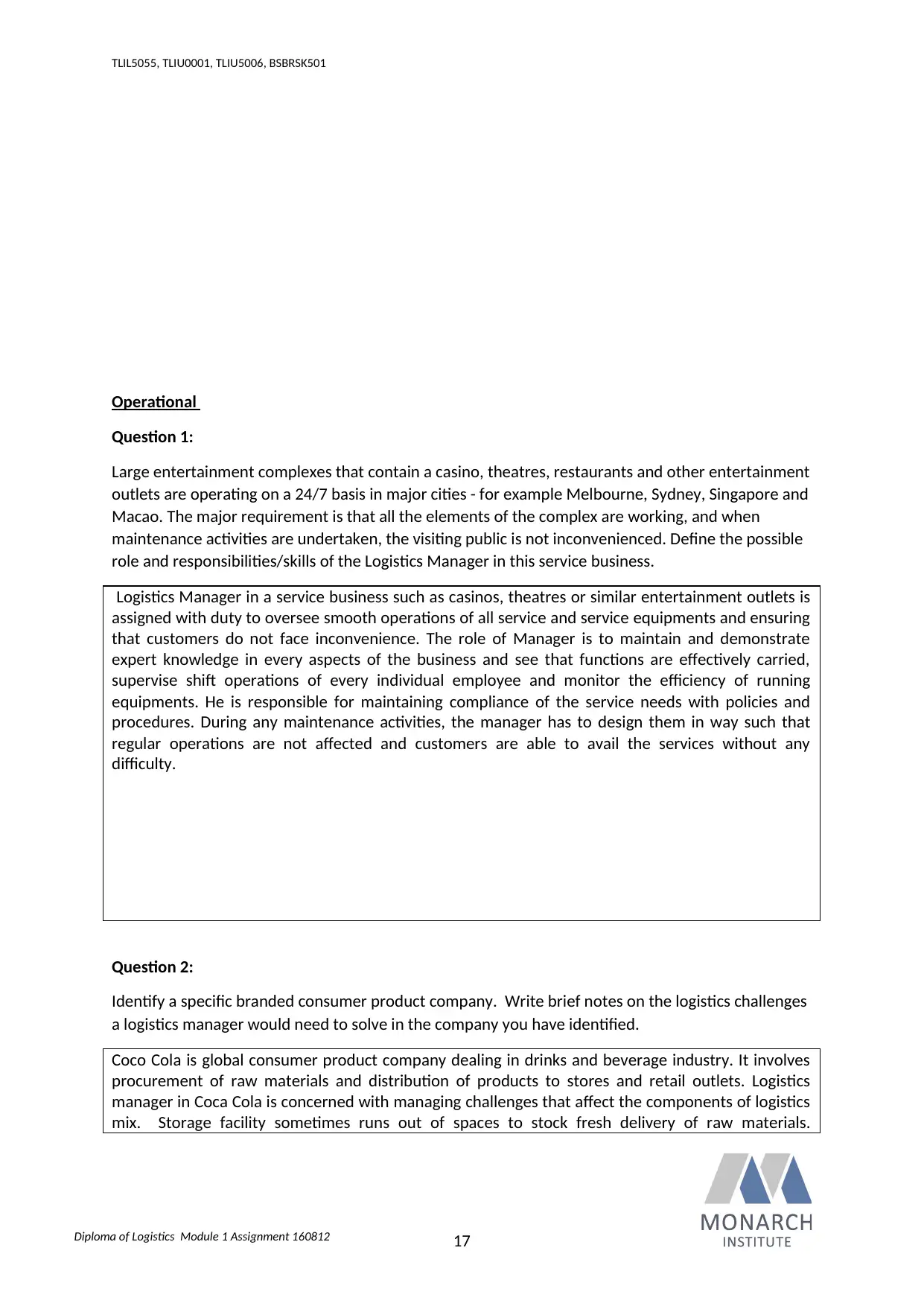
Diploma of Logistics Module 1 Assignment 160812
TLIL5055, TLIU0001, TLIU5006, BSBRSK501
Operational
Question 1:
Large entertainment complexes that contain a casino, theatres, restaurants and other entertainment
outlets are operating on a 24/7 basis in major cities - for example Melbourne, Sydney, Singapore and
Macao. The major requirement is that all the elements of the complex are working, and when
maintenance activities are undertaken, the visiting public is not inconvenienced. Define the possible
role and responsibilities/skills of the Logistics Manager in this service business.
Logistics Manager in a service business such as casinos, theatres or similar entertainment outlets is
assigned with duty to oversee smooth operations of all service and service equipments and ensuring
that customers do not face inconvenience. The role of Manager is to maintain and demonstrate
expert knowledge in every aspects of the business and see that functions are effectively carried,
supervise shift operations of every individual employee and monitor the efficiency of running
equipments. He is responsible for maintaining compliance of the service needs with policies and
procedures. During any maintenance activities, the manager has to design them in way such that
regular operations are not affected and customers are able to avail the services without any
difficulty.
Question 2:
Identify a specific branded consumer product company. Write brief notes on the logistics challenges
a logistics manager would need to solve in the company you have identified.
Coco Cola is global consumer product company dealing in drinks and beverage industry. It involves
procurement of raw materials and distribution of products to stores and retail outlets. Logistics
manager in Coca Cola is concerned with managing challenges that affect the components of logistics
mix. Storage facility sometimes runs out of spaces to stock fresh delivery of raw materials.
17
TLIL5055, TLIU0001, TLIU5006, BSBRSK501
Operational
Question 1:
Large entertainment complexes that contain a casino, theatres, restaurants and other entertainment
outlets are operating on a 24/7 basis in major cities - for example Melbourne, Sydney, Singapore and
Macao. The major requirement is that all the elements of the complex are working, and when
maintenance activities are undertaken, the visiting public is not inconvenienced. Define the possible
role and responsibilities/skills of the Logistics Manager in this service business.
Logistics Manager in a service business such as casinos, theatres or similar entertainment outlets is
assigned with duty to oversee smooth operations of all service and service equipments and ensuring
that customers do not face inconvenience. The role of Manager is to maintain and demonstrate
expert knowledge in every aspects of the business and see that functions are effectively carried,
supervise shift operations of every individual employee and monitor the efficiency of running
equipments. He is responsible for maintaining compliance of the service needs with policies and
procedures. During any maintenance activities, the manager has to design them in way such that
regular operations are not affected and customers are able to avail the services without any
difficulty.
Question 2:
Identify a specific branded consumer product company. Write brief notes on the logistics challenges
a logistics manager would need to solve in the company you have identified.
Coco Cola is global consumer product company dealing in drinks and beverage industry. It involves
procurement of raw materials and distribution of products to stores and retail outlets. Logistics
manager in Coca Cola is concerned with managing challenges that affect the components of logistics
mix. Storage facility sometimes runs out of spaces to stock fresh delivery of raw materials.
17
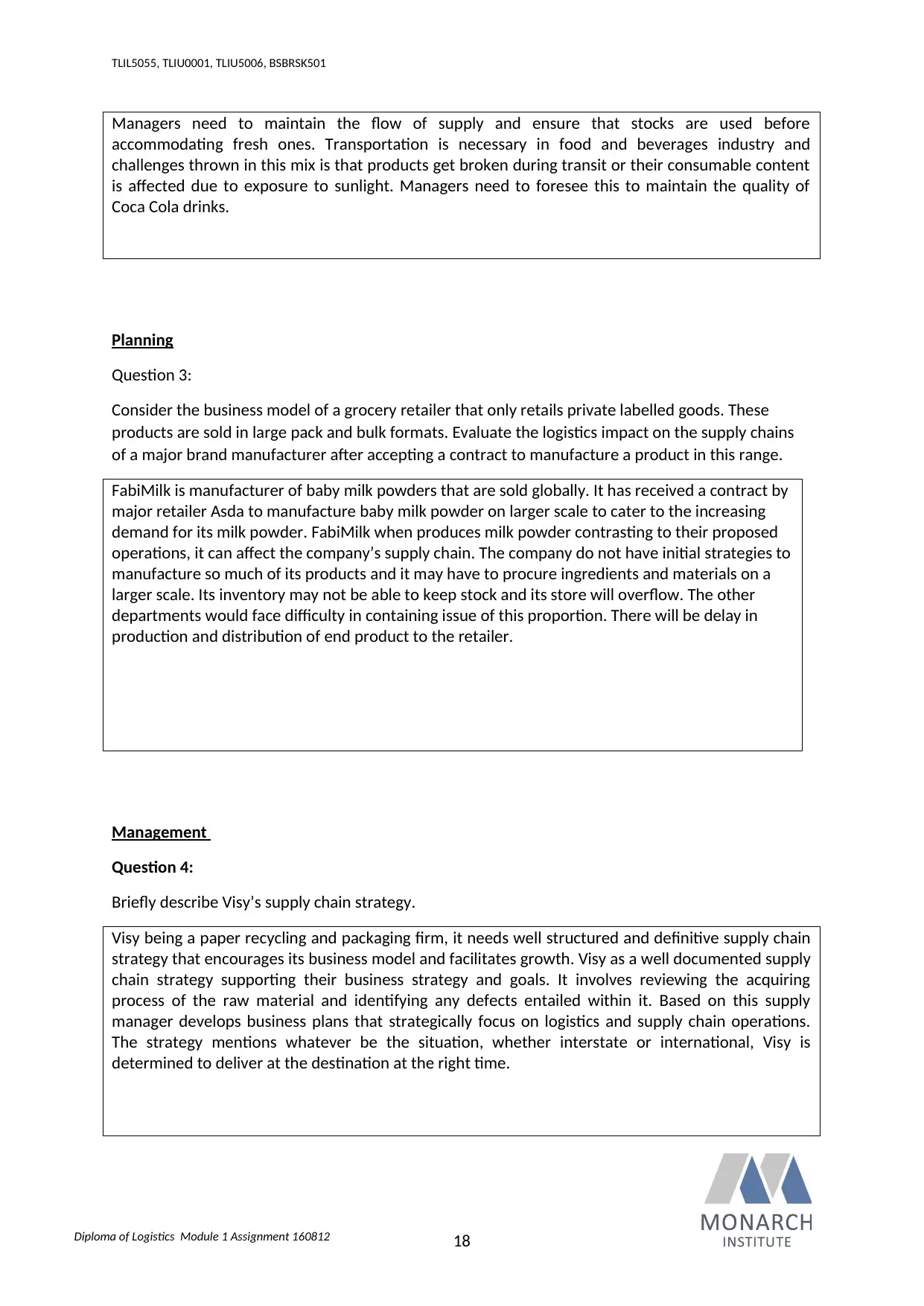
Diploma of Logistics Module 1 Assignment 160812
TLIL5055, TLIU0001, TLIU5006, BSBRSK501
Managers need to maintain the flow of supply and ensure that stocks are used before
accommodating fresh ones. Transportation is necessary in food and beverages industry and
challenges thrown in this mix is that products get broken during transit or their consumable content
is affected due to exposure to sunlight. Managers need to foresee this to maintain the quality of
Coca Cola drinks.
Planning
Question 3:
Consider the business model of a grocery retailer that only retails private labelled goods. These
products are sold in large pack and bulk formats. Evaluate the logistics impact on the supply chains
of a major brand manufacturer after accepting a contract to manufacture a product in this range.
FabiMilk is manufacturer of baby milk powders that are sold globally. It has received a contract by
major retailer Asda to manufacture baby milk powder on larger scale to cater to the increasing
demand for its milk powder. FabiMilk when produces milk powder contrasting to their proposed
operations, it can affect the company’s supply chain. The company do not have initial strategies to
manufacture so much of its products and it may have to procure ingredients and materials on a
larger scale. Its inventory may not be able to keep stock and its store will overflow. The other
departments would face difficulty in containing issue of this proportion. There will be delay in
production and distribution of end product to the retailer.
Management
Question 4:
Briefly describe Visy’s supply chain strategy.
Visy being a paper recycling and packaging firm, it needs well structured and definitive supply chain
strategy that encourages its business model and facilitates growth. Visy as a well documented supply
chain strategy supporting their business strategy and goals. It involves reviewing the acquiring
process of the raw material and identifying any defects entailed within it. Based on this supply
manager develops business plans that strategically focus on logistics and supply chain operations.
The strategy mentions whatever be the situation, whether interstate or international, Visy is
determined to deliver at the destination at the right time.
18
TLIL5055, TLIU0001, TLIU5006, BSBRSK501
Managers need to maintain the flow of supply and ensure that stocks are used before
accommodating fresh ones. Transportation is necessary in food and beverages industry and
challenges thrown in this mix is that products get broken during transit or their consumable content
is affected due to exposure to sunlight. Managers need to foresee this to maintain the quality of
Coca Cola drinks.
Planning
Question 3:
Consider the business model of a grocery retailer that only retails private labelled goods. These
products are sold in large pack and bulk formats. Evaluate the logistics impact on the supply chains
of a major brand manufacturer after accepting a contract to manufacture a product in this range.
FabiMilk is manufacturer of baby milk powders that are sold globally. It has received a contract by
major retailer Asda to manufacture baby milk powder on larger scale to cater to the increasing
demand for its milk powder. FabiMilk when produces milk powder contrasting to their proposed
operations, it can affect the company’s supply chain. The company do not have initial strategies to
manufacture so much of its products and it may have to procure ingredients and materials on a
larger scale. Its inventory may not be able to keep stock and its store will overflow. The other
departments would face difficulty in containing issue of this proportion. There will be delay in
production and distribution of end product to the retailer.
Management
Question 4:
Briefly describe Visy’s supply chain strategy.
Visy being a paper recycling and packaging firm, it needs well structured and definitive supply chain
strategy that encourages its business model and facilitates growth. Visy as a well documented supply
chain strategy supporting their business strategy and goals. It involves reviewing the acquiring
process of the raw material and identifying any defects entailed within it. Based on this supply
manager develops business plans that strategically focus on logistics and supply chain operations.
The strategy mentions whatever be the situation, whether interstate or international, Visy is
determined to deliver at the destination at the right time.
18
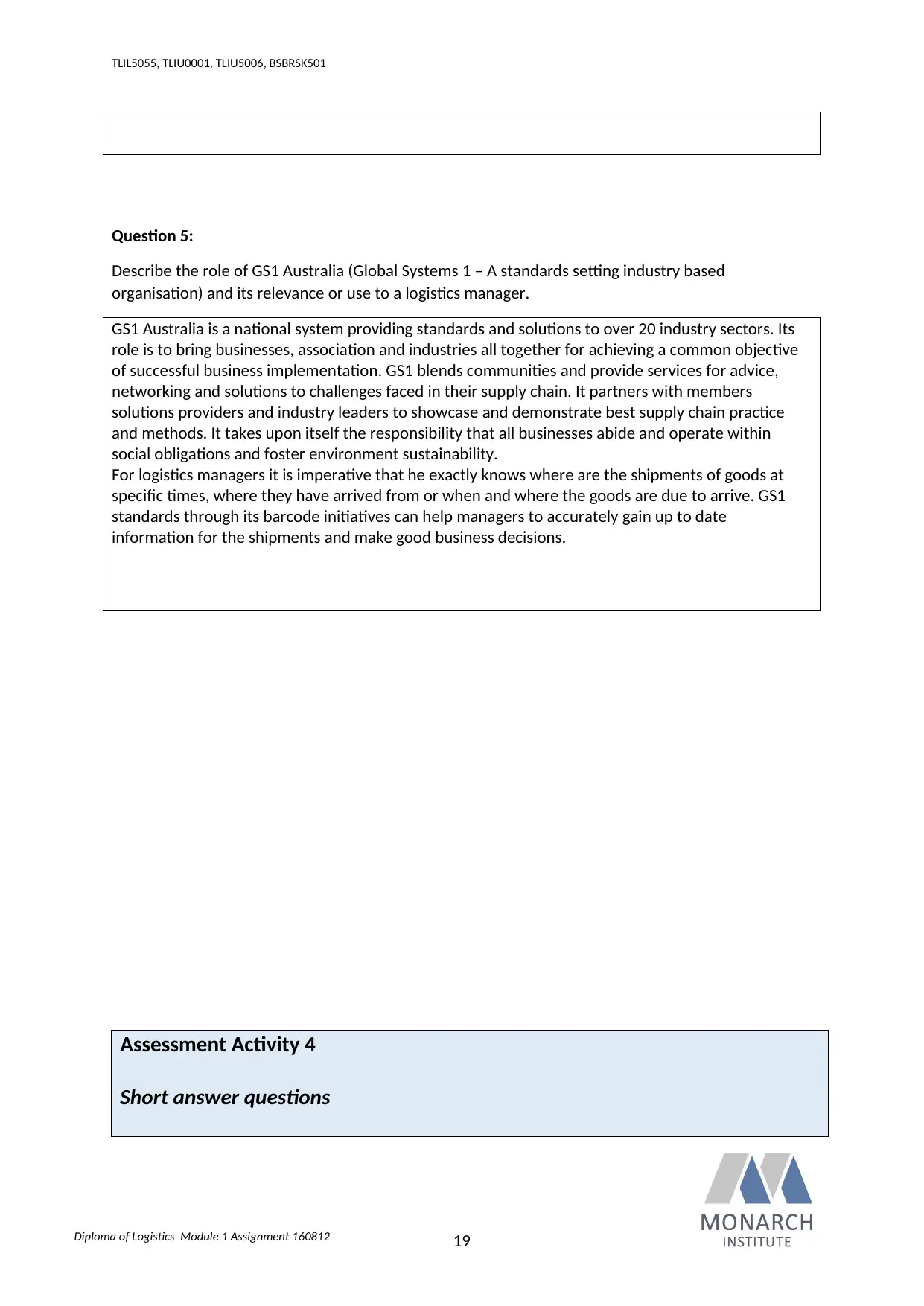
Diploma of Logistics Module 1 Assignment 160812
TLIL5055, TLIU0001, TLIU5006, BSBRSK501
Question 5:
Describe the role of GS1 Australia (Global Systems 1 – A standards setting industry based
organisation) and its relevance or use to a logistics manager.
GS1 Australia is a national system providing standards and solutions to over 20 industry sectors. Its
role is to bring businesses, association and industries all together for achieving a common objective
of successful business implementation. GS1 blends communities and provide services for advice,
networking and solutions to challenges faced in their supply chain. It partners with members
solutions providers and industry leaders to showcase and demonstrate best supply chain practice
and methods. It takes upon itself the responsibility that all businesses abide and operate within
social obligations and foster environment sustainability.
For logistics managers it is imperative that he exactly knows where are the shipments of goods at
specific times, where they have arrived from or when and where the goods are due to arrive. GS1
standards through its barcode initiatives can help managers to accurately gain up to date
information for the shipments and make good business decisions.
Assessment Activity 4
Short answer questions
19
TLIL5055, TLIU0001, TLIU5006, BSBRSK501
Question 5:
Describe the role of GS1 Australia (Global Systems 1 – A standards setting industry based
organisation) and its relevance or use to a logistics manager.
GS1 Australia is a national system providing standards and solutions to over 20 industry sectors. Its
role is to bring businesses, association and industries all together for achieving a common objective
of successful business implementation. GS1 blends communities and provide services for advice,
networking and solutions to challenges faced in their supply chain. It partners with members
solutions providers and industry leaders to showcase and demonstrate best supply chain practice
and methods. It takes upon itself the responsibility that all businesses abide and operate within
social obligations and foster environment sustainability.
For logistics managers it is imperative that he exactly knows where are the shipments of goods at
specific times, where they have arrived from or when and where the goods are due to arrive. GS1
standards through its barcode initiatives can help managers to accurately gain up to date
information for the shipments and make good business decisions.
Assessment Activity 4
Short answer questions
19
Paraphrase This Document
Need a fresh take? Get an instant paraphrase of this document with our AI Paraphraser
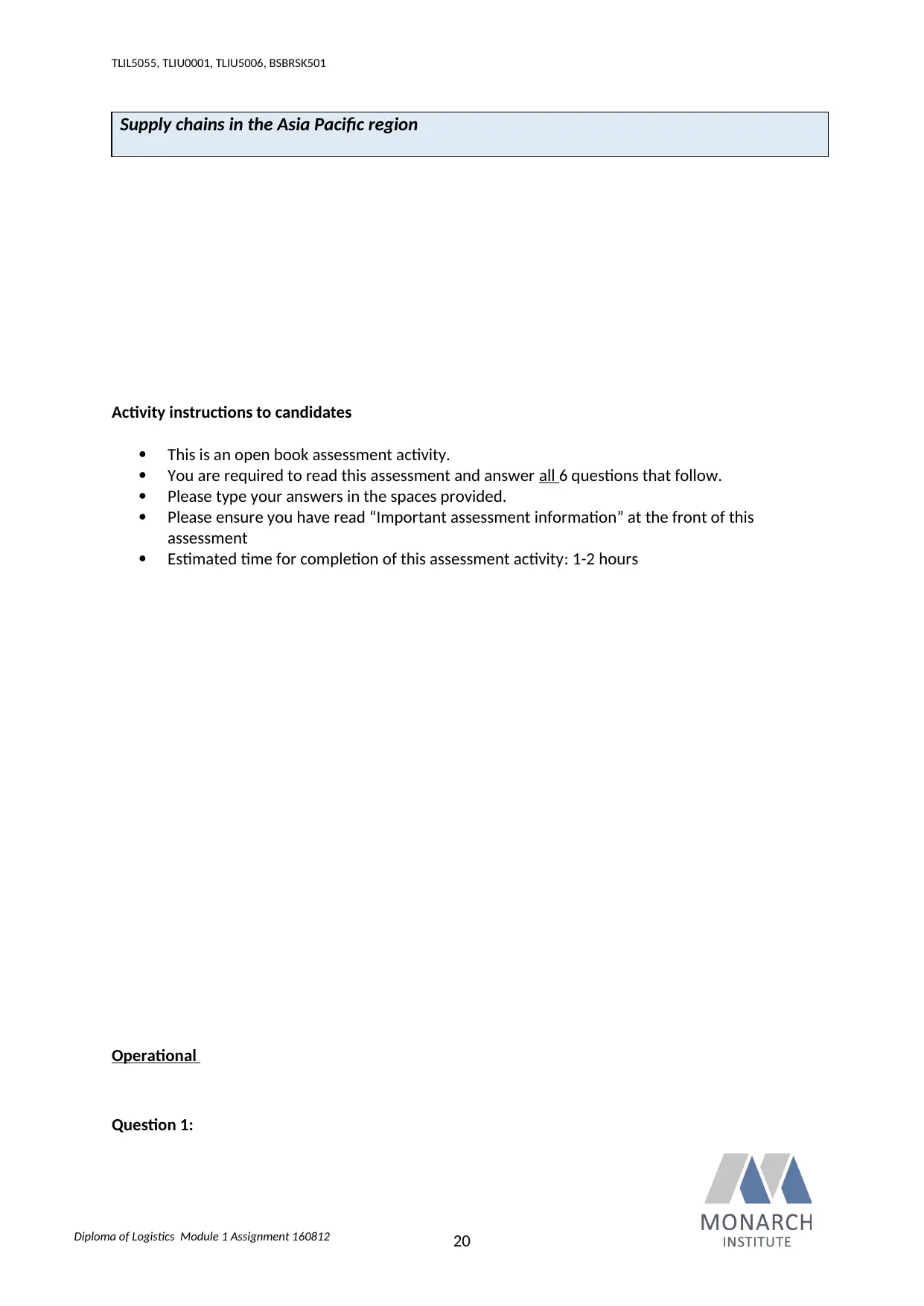
Diploma of Logistics Module 1 Assignment 160812
TLIL5055, TLIU0001, TLIU5006, BSBRSK501
Supply chains in the Asia Pacific region
Activity instructions to candidates
This is an open book assessment activity.
You are required to read this assessment and answer all 6 questions that follow.
Please type your answers in the spaces provided.
Please ensure you have read “Important assessment information” at the front of this
assessment
Estimated time for completion of this assessment activity: 1-2 hours
Operational
Question 1:
20
TLIL5055, TLIU0001, TLIU5006, BSBRSK501
Supply chains in the Asia Pacific region
Activity instructions to candidates
This is an open book assessment activity.
You are required to read this assessment and answer all 6 questions that follow.
Please type your answers in the spaces provided.
Please ensure you have read “Important assessment information” at the front of this
assessment
Estimated time for completion of this assessment activity: 1-2 hours
Operational
Question 1:
20

Diploma of Logistics Module 1 Assignment 160812
TLIL5055, TLIU0001, TLIU5006, BSBRSK501
Consider your own city or town in Australia and its infrastructure. Describe how the transport
infrastructure affects the logistics operation of a FMCG company.
Be sure to identify the city or town in your answer and the FMCG Company you have selected.
The city to be considered in this respect would be that of Perth in Australia and the FMCG
Company which the process is going to deal with is the Wesfarmers Limited which is also
headquartered at the city of Perth. The logistical operations of any FMCG Company
completely rely intensely upon the measure of efficiency of the involved transport
infrastructure system. The transport infrastructure is the central ingredient in the process of
the time and spatial economic utility management regarding the task performance of any of
the FMCG Companies. So is the case with the Wesfarmers Limited. The availability of
Multidimensional transportation options, which are present in the city of Perth, has a long
lasting and far reaching impact on the efficiency of the FMCG Company regarding the
planning, implementation and control mechanism operations which ensure the efficient
progression of the products, shipments and goods and services towards the designated
destination. The transportation infrastructure is the core component of the logistical
operations regarding the tasks of the FMCG Company such as the Wesfarmers Limited and it
significantly impacts the ability of the company to move the goods and products between the
different points in the supply network through utilisation of the transport infrastructure of the
entire cityscape of Perth.
Question 2:
What are the advantages and disadvantages for CPG and FMCG company’s operations in cities with
high population densities?
The operations of the Consumer Packaged Goods companies or the Fast Mover Consumer
Goods companies are dependent on various factors which influence the measure of success or
failure regarding the business investment in the processes of goods transportation by the
logistical transportation facilities which these companies operate. Various advantages and
21
TLIL5055, TLIU0001, TLIU5006, BSBRSK501
Consider your own city or town in Australia and its infrastructure. Describe how the transport
infrastructure affects the logistics operation of a FMCG company.
Be sure to identify the city or town in your answer and the FMCG Company you have selected.
The city to be considered in this respect would be that of Perth in Australia and the FMCG
Company which the process is going to deal with is the Wesfarmers Limited which is also
headquartered at the city of Perth. The logistical operations of any FMCG Company
completely rely intensely upon the measure of efficiency of the involved transport
infrastructure system. The transport infrastructure is the central ingredient in the process of
the time and spatial economic utility management regarding the task performance of any of
the FMCG Companies. So is the case with the Wesfarmers Limited. The availability of
Multidimensional transportation options, which are present in the city of Perth, has a long
lasting and far reaching impact on the efficiency of the FMCG Company regarding the
planning, implementation and control mechanism operations which ensure the efficient
progression of the products, shipments and goods and services towards the designated
destination. The transportation infrastructure is the core component of the logistical
operations regarding the tasks of the FMCG Company such as the Wesfarmers Limited and it
significantly impacts the ability of the company to move the goods and products between the
different points in the supply network through utilisation of the transport infrastructure of the
entire cityscape of Perth.
Question 2:
What are the advantages and disadvantages for CPG and FMCG company’s operations in cities with
high population densities?
The operations of the Consumer Packaged Goods companies or the Fast Mover Consumer
Goods companies are dependent on various factors which influence the measure of success or
failure regarding the business investment in the processes of goods transportation by the
logistical transportation facilities which these companies operate. Various advantages and
21

Diploma of Logistics Module 1 Assignment 160812
TLIL5055, TLIU0001, TLIU5006, BSBRSK501
disadvantages are experienced by these companies concerning their operations in the densely
populated city centres and residential areas situated throughout the country of Australia. The
Fast moving Consumer Goods companies have to maintain their transportation schedules to
deliver their products to the proper destinations to make a reasonable profit margin in the
retail business. In this context, the CPG or the FMCG companies can experience the
advantages of operating in the populated sections of the cities through earning the key benefit
of the cumulative profit through the selling of small percentage of their goods and products as
each unit sale fetches greater quantitative profit because of the availability of customers in the
close vicinity. This also entails the fact that the goods and products need not to be moved to
considerable distances to be delivered to the retail shops as most such retail outlets are
situated within the premises of such populated regions. This adds to the total profit in the
fiscal operating period of the companies. On the other hand the single greatest disadvantage
that could be identified regarding the CPGs or the FMCGs having to operate in the densely
crowded city section is that the city transportation gets invariably clogged with greater
numbers of commuters during the morning rush hours and during the delivery periods when
the companies generally transport their merchandises and this adds to the backlogging of the
delivery schedule and the addition to the transportation costs which the companies have to
accumulate in cases of delivery schedule lapses where the companies become legally liable to
pay monetary penalties.
22
TLIL5055, TLIU0001, TLIU5006, BSBRSK501
disadvantages are experienced by these companies concerning their operations in the densely
populated city centres and residential areas situated throughout the country of Australia. The
Fast moving Consumer Goods companies have to maintain their transportation schedules to
deliver their products to the proper destinations to make a reasonable profit margin in the
retail business. In this context, the CPG or the FMCG companies can experience the
advantages of operating in the populated sections of the cities through earning the key benefit
of the cumulative profit through the selling of small percentage of their goods and products as
each unit sale fetches greater quantitative profit because of the availability of customers in the
close vicinity. This also entails the fact that the goods and products need not to be moved to
considerable distances to be delivered to the retail shops as most such retail outlets are
situated within the premises of such populated regions. This adds to the total profit in the
fiscal operating period of the companies. On the other hand the single greatest disadvantage
that could be identified regarding the CPGs or the FMCGs having to operate in the densely
crowded city section is that the city transportation gets invariably clogged with greater
numbers of commuters during the morning rush hours and during the delivery periods when
the companies generally transport their merchandises and this adds to the backlogging of the
delivery schedule and the addition to the transportation costs which the companies have to
accumulate in cases of delivery schedule lapses where the companies become legally liable to
pay monetary penalties.
22
Secure Best Marks with AI Grader
Need help grading? Try our AI Grader for instant feedback on your assignments.
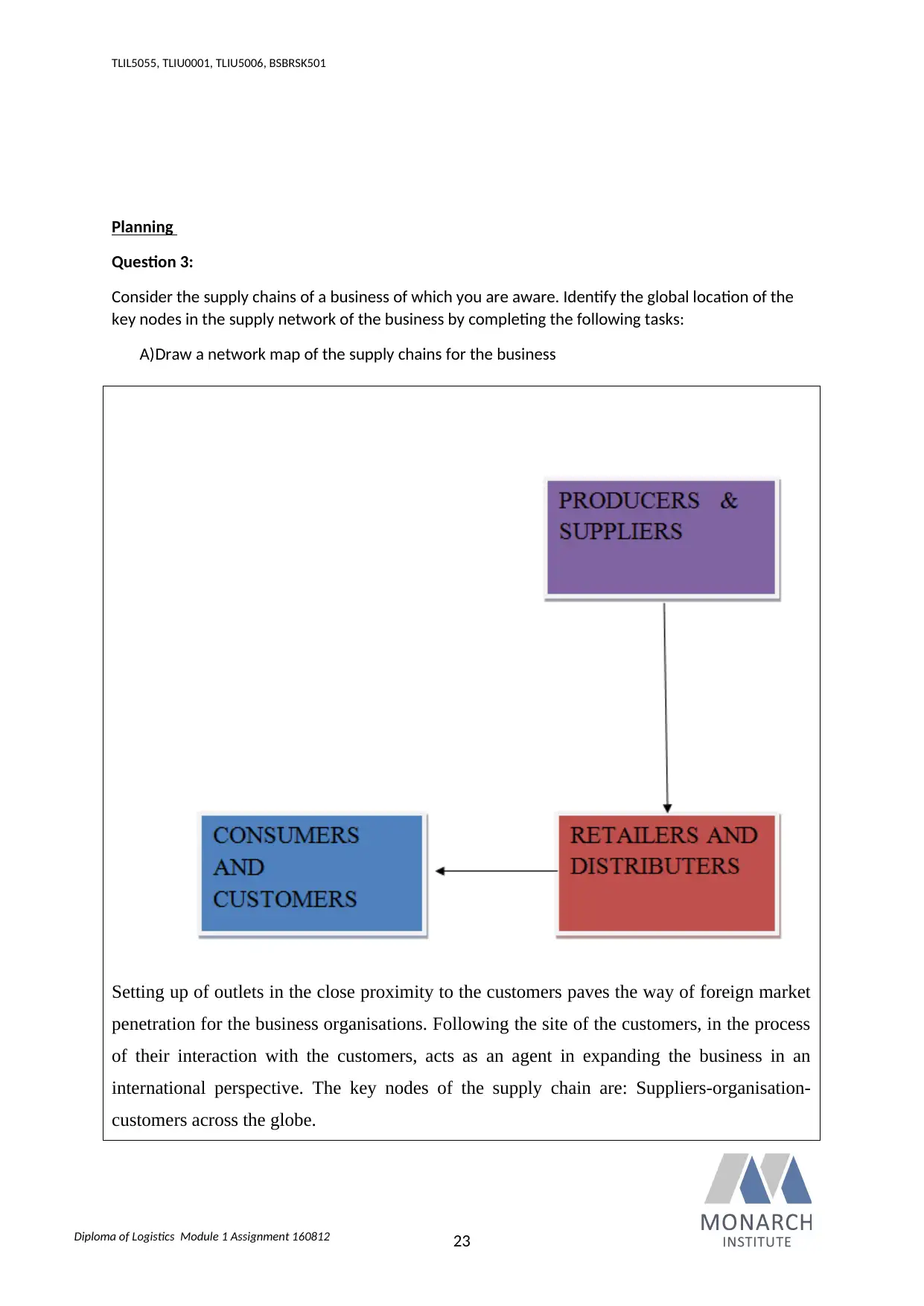
Diploma of Logistics Module 1 Assignment 160812
TLIL5055, TLIU0001, TLIU5006, BSBRSK501
Planning
Question 3:
Consider the supply chains of a business of which you are aware. Identify the global location of the
key nodes in the supply network of the business by completing the following tasks:
A)Draw a network map of the supply chains for the business
Setting up of outlets in the close proximity to the customers paves the way of foreign market
penetration for the business organisations. Following the site of the customers, in the process
of their interaction with the customers, acts as an agent in expanding the business in an
international perspective. The key nodes of the supply chain are: Suppliers-organisation-
customers across the globe.
23
TLIL5055, TLIU0001, TLIU5006, BSBRSK501
Planning
Question 3:
Consider the supply chains of a business of which you are aware. Identify the global location of the
key nodes in the supply network of the business by completing the following tasks:
A)Draw a network map of the supply chains for the business
Setting up of outlets in the close proximity to the customers paves the way of foreign market
penetration for the business organisations. Following the site of the customers, in the process
of their interaction with the customers, acts as an agent in expanding the business in an
international perspective. The key nodes of the supply chain are: Suppliers-organisation-
customers across the globe.
23

Diploma of Logistics Module 1 Assignment 160812
TLIL5055, TLIU0001, TLIU5006, BSBRSK501
Upon the identification the needs, demands and requirements of the customers, the
organisation conveys it to the shareholders. These are the distributors, suppliers among
others. Maintenance of coordination in this network simultaneously maintains the balance in
the supply chain management. A breach in any one of the nodes destroys the systematic
process of supply chain. This situation degrades the reputation of the business organisations
among the customers.
B) Discuss the key constraints of this network,
Financial and time constraints are the major obstacles, which stalls the balance of the supply
chain network. Along with this, imposition of restrictions and harsh policies limit the free
flow of goods from the suppliers to the native organisation. This adversely affects the needs
of the customers. Continuity of this situation turns the integrated structure of the supply chain
into a disrupted one, which projects noticeable decline in the profit margin of the
organisations.
Apart from the, possession of inadequate resources aggravates the complexities of the
organisations in terms of exporting the ordered materials within the stipulated time. This
drawback leads to issues, such as customer turnover.
Absence of proper orientation compels the organisations to encounter crisis towards the last
phase of the project. This absence stains the personality of the employees as well as the
organisation as a whole. Moreover, it provides the opportunity to the other contemporary
24
TLIL5055, TLIU0001, TLIU5006, BSBRSK501
Upon the identification the needs, demands and requirements of the customers, the
organisation conveys it to the shareholders. These are the distributors, suppliers among
others. Maintenance of coordination in this network simultaneously maintains the balance in
the supply chain management. A breach in any one of the nodes destroys the systematic
process of supply chain. This situation degrades the reputation of the business organisations
among the customers.
B) Discuss the key constraints of this network,
Financial and time constraints are the major obstacles, which stalls the balance of the supply
chain network. Along with this, imposition of restrictions and harsh policies limit the free
flow of goods from the suppliers to the native organisation. This adversely affects the needs
of the customers. Continuity of this situation turns the integrated structure of the supply chain
into a disrupted one, which projects noticeable decline in the profit margin of the
organisations.
Apart from the, possession of inadequate resources aggravates the complexities of the
organisations in terms of exporting the ordered materials within the stipulated time. This
drawback leads to issues, such as customer turnover.
Absence of proper orientation compels the organisations to encounter crisis towards the last
phase of the project. This absence stains the personality of the employees as well as the
organisation as a whole. Moreover, it provides the opportunity to the other contemporary
24

Diploma of Logistics Module 1 Assignment 160812
TLIL5055, TLIU0001, TLIU5006, BSBRSK501
brands to give tough competition to the native organisation in terms of attainment of the peak
position in the ambience of competition.
C)How could the business overcome or leverage these constraints?
The creation and development of effective plans would help the company to systematise the
allocated tasks. Indulging in meetings and conferences with the stakeholders and shareholders
would be an additional assistance for the organisations in achieving possible solutions for
overcoming the identified problems. Maintenance of frequency in the execution of evaluation
process would help the organisation to assess their current performance in terms of the
business requirements. This assessment would, further, aid in the completion of the tasks
within the stipulated time. Taking into consideration the opinions of the stakeholders and
shareholders would act as an agent in improving the services of the company, which would
restore the lost glory.
Question 4:
When obtaining products and materials from countries ranked as Logistics Emerging in the Logistics
Performance Index (LPI) Rankings 2010 (page 47 of your textbook), what planning parameters
should be put in place to ensure there is sufficient supply?
While obtaining the products and materials from the Logistics Emerging countries according
to the Logistics Performance Index, the planning parameters which would be necessitated to
25
TLIL5055, TLIU0001, TLIU5006, BSBRSK501
brands to give tough competition to the native organisation in terms of attainment of the peak
position in the ambience of competition.
C)How could the business overcome or leverage these constraints?
The creation and development of effective plans would help the company to systematise the
allocated tasks. Indulging in meetings and conferences with the stakeholders and shareholders
would be an additional assistance for the organisations in achieving possible solutions for
overcoming the identified problems. Maintenance of frequency in the execution of evaluation
process would help the organisation to assess their current performance in terms of the
business requirements. This assessment would, further, aid in the completion of the tasks
within the stipulated time. Taking into consideration the opinions of the stakeholders and
shareholders would act as an agent in improving the services of the company, which would
restore the lost glory.
Question 4:
When obtaining products and materials from countries ranked as Logistics Emerging in the Logistics
Performance Index (LPI) Rankings 2010 (page 47 of your textbook), what planning parameters
should be put in place to ensure there is sufficient supply?
While obtaining the products and materials from the Logistics Emerging countries according
to the Logistics Performance Index, the planning parameters which would be necessitated to
25
Paraphrase This Document
Need a fresh take? Get an instant paraphrase of this document with our AI Paraphraser
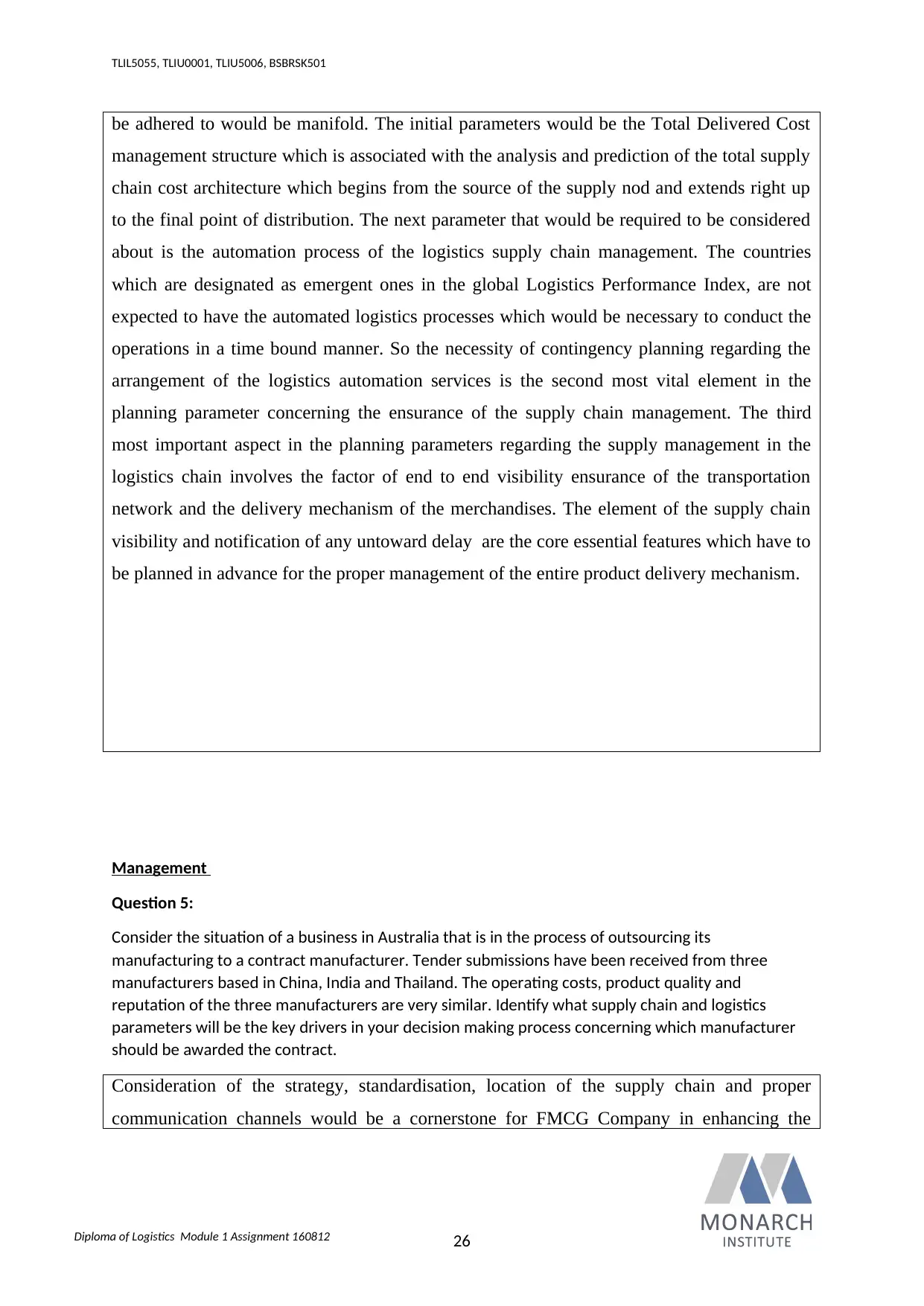
Diploma of Logistics Module 1 Assignment 160812
TLIL5055, TLIU0001, TLIU5006, BSBRSK501
be adhered to would be manifold. The initial parameters would be the Total Delivered Cost
management structure which is associated with the analysis and prediction of the total supply
chain cost architecture which begins from the source of the supply nod and extends right up
to the final point of distribution. The next parameter that would be required to be considered
about is the automation process of the logistics supply chain management. The countries
which are designated as emergent ones in the global Logistics Performance Index, are not
expected to have the automated logistics processes which would be necessary to conduct the
operations in a time bound manner. So the necessity of contingency planning regarding the
arrangement of the logistics automation services is the second most vital element in the
planning parameter concerning the ensurance of the supply chain management. The third
most important aspect in the planning parameters regarding the supply management in the
logistics chain involves the factor of end to end visibility ensurance of the transportation
network and the delivery mechanism of the merchandises. The element of the supply chain
visibility and notification of any untoward delay are the core essential features which have to
be planned in advance for the proper management of the entire product delivery mechanism.
Management
Question 5:
Consider the situation of a business in Australia that is in the process of outsourcing its
manufacturing to a contract manufacturer. Tender submissions have been received from three
manufacturers based in China, India and Thailand. The operating costs, product quality and
reputation of the three manufacturers are very similar. Identify what supply chain and logistics
parameters will be the key drivers in your decision making process concerning which manufacturer
should be awarded the contract.
Consideration of the strategy, standardisation, location of the supply chain and proper
communication channels would be a cornerstone for FMCG Company in enhancing the
26
TLIL5055, TLIU0001, TLIU5006, BSBRSK501
be adhered to would be manifold. The initial parameters would be the Total Delivered Cost
management structure which is associated with the analysis and prediction of the total supply
chain cost architecture which begins from the source of the supply nod and extends right up
to the final point of distribution. The next parameter that would be required to be considered
about is the automation process of the logistics supply chain management. The countries
which are designated as emergent ones in the global Logistics Performance Index, are not
expected to have the automated logistics processes which would be necessary to conduct the
operations in a time bound manner. So the necessity of contingency planning regarding the
arrangement of the logistics automation services is the second most vital element in the
planning parameter concerning the ensurance of the supply chain management. The third
most important aspect in the planning parameters regarding the supply management in the
logistics chain involves the factor of end to end visibility ensurance of the transportation
network and the delivery mechanism of the merchandises. The element of the supply chain
visibility and notification of any untoward delay are the core essential features which have to
be planned in advance for the proper management of the entire product delivery mechanism.
Management
Question 5:
Consider the situation of a business in Australia that is in the process of outsourcing its
manufacturing to a contract manufacturer. Tender submissions have been received from three
manufacturers based in China, India and Thailand. The operating costs, product quality and
reputation of the three manufacturers are very similar. Identify what supply chain and logistics
parameters will be the key drivers in your decision making process concerning which manufacturer
should be awarded the contract.
Consideration of the strategy, standardisation, location of the supply chain and proper
communication channels would be a cornerstone for FMCG Company in enhancing the
26
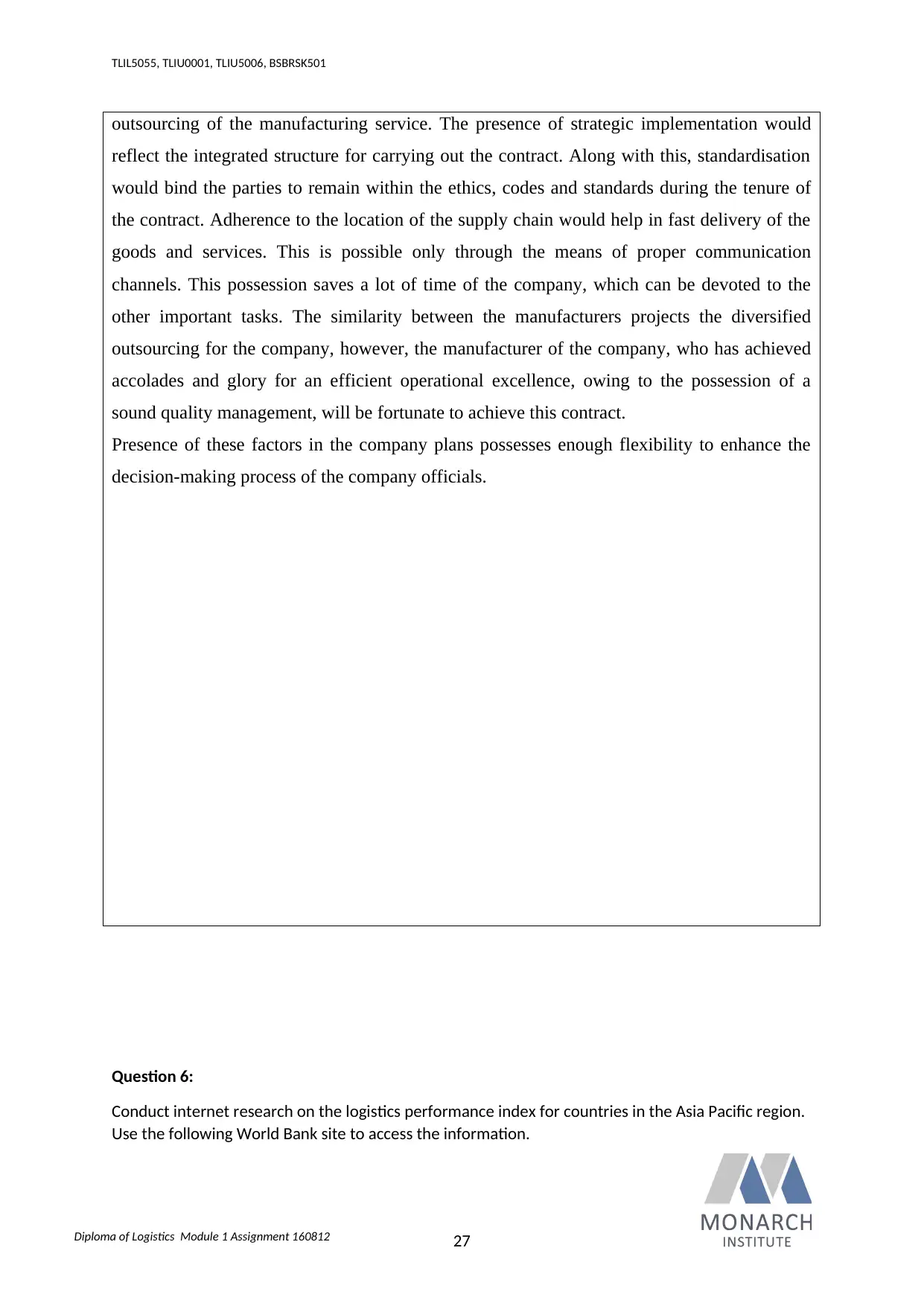
Diploma of Logistics Module 1 Assignment 160812
TLIL5055, TLIU0001, TLIU5006, BSBRSK501
outsourcing of the manufacturing service. The presence of strategic implementation would
reflect the integrated structure for carrying out the contract. Along with this, standardisation
would bind the parties to remain within the ethics, codes and standards during the tenure of
the contract. Adherence to the location of the supply chain would help in fast delivery of the
goods and services. This is possible only through the means of proper communication
channels. This possession saves a lot of time of the company, which can be devoted to the
other important tasks. The similarity between the manufacturers projects the diversified
outsourcing for the company, however, the manufacturer of the company, who has achieved
accolades and glory for an efficient operational excellence, owing to the possession of a
sound quality management, will be fortunate to achieve this contract.
Presence of these factors in the company plans possesses enough flexibility to enhance the
decision-making process of the company officials.
Question 6:
Conduct internet research on the logistics performance index for countries in the Asia Pacific region.
Use the following World Bank site to access the information.
27
TLIL5055, TLIU0001, TLIU5006, BSBRSK501
outsourcing of the manufacturing service. The presence of strategic implementation would
reflect the integrated structure for carrying out the contract. Along with this, standardisation
would bind the parties to remain within the ethics, codes and standards during the tenure of
the contract. Adherence to the location of the supply chain would help in fast delivery of the
goods and services. This is possible only through the means of proper communication
channels. This possession saves a lot of time of the company, which can be devoted to the
other important tasks. The similarity between the manufacturers projects the diversified
outsourcing for the company, however, the manufacturer of the company, who has achieved
accolades and glory for an efficient operational excellence, owing to the possession of a
sound quality management, will be fortunate to achieve this contract.
Presence of these factors in the company plans possesses enough flexibility to enhance the
decision-making process of the company officials.
Question 6:
Conduct internet research on the logistics performance index for countries in the Asia Pacific region.
Use the following World Bank site to access the information.
27
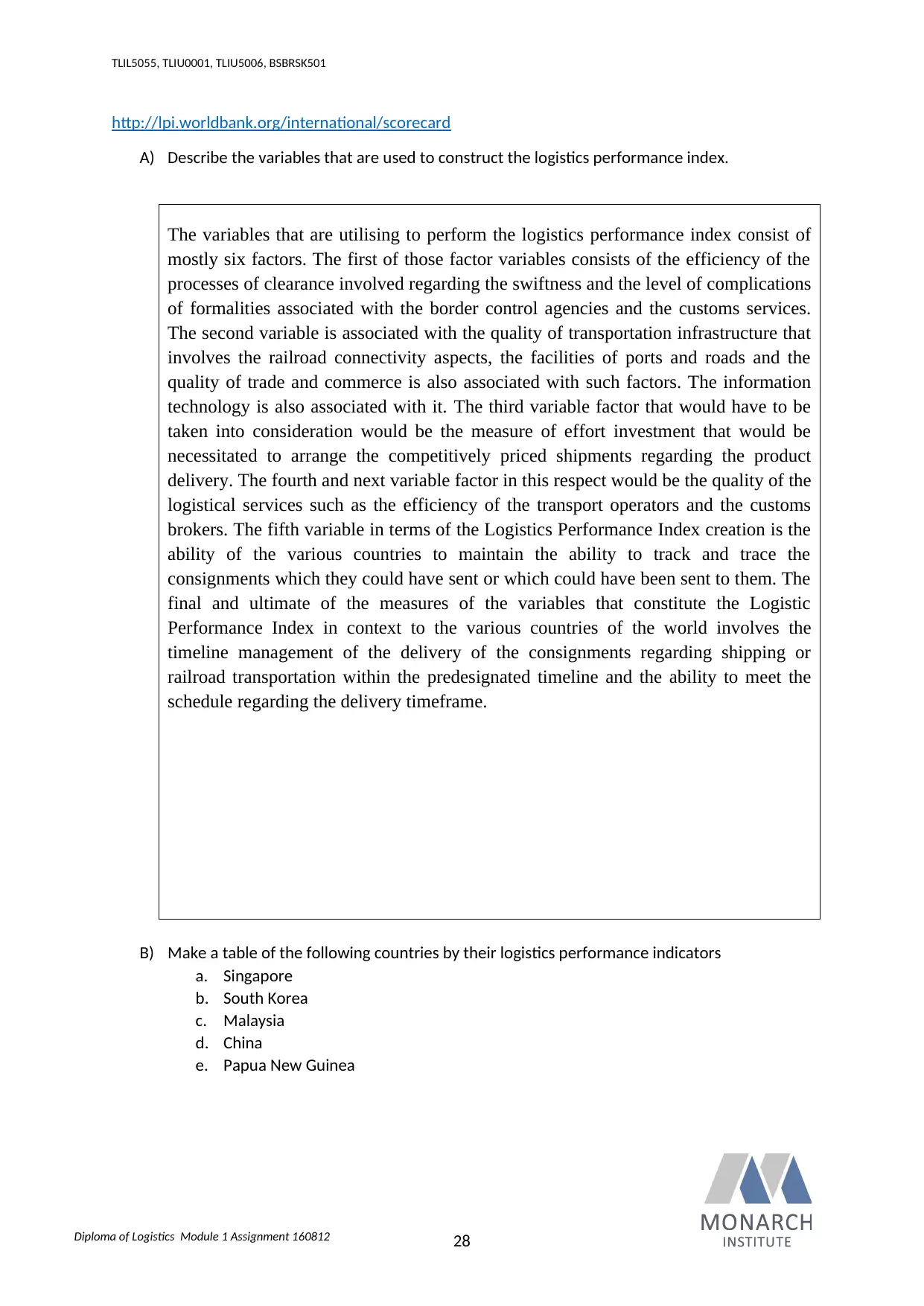
Diploma of Logistics Module 1 Assignment 160812
TLIL5055, TLIU0001, TLIU5006, BSBRSK501
http://lpi.worldbank.org/international/scorecard
A) Describe the variables that are used to construct the logistics performance index.
The variables that are utilising to perform the logistics performance index consist of
mostly six factors. The first of those factor variables consists of the efficiency of the
processes of clearance involved regarding the swiftness and the level of complications
of formalities associated with the border control agencies and the customs services.
The second variable is associated with the quality of transportation infrastructure that
involves the railroad connectivity aspects, the facilities of ports and roads and the
quality of trade and commerce is also associated with such factors. The information
technology is also associated with it. The third variable factor that would have to be
taken into consideration would be the measure of effort investment that would be
necessitated to arrange the competitively priced shipments regarding the product
delivery. The fourth and next variable factor in this respect would be the quality of the
logistical services such as the efficiency of the transport operators and the customs
brokers. The fifth variable in terms of the Logistics Performance Index creation is the
ability of the various countries to maintain the ability to track and trace the
consignments which they could have sent or which could have been sent to them. The
final and ultimate of the measures of the variables that constitute the Logistic
Performance Index in context to the various countries of the world involves the
timeline management of the delivery of the consignments regarding shipping or
railroad transportation within the predesignated timeline and the ability to meet the
schedule regarding the delivery timeframe.
B) Make a table of the following countries by their logistics performance indicators
a. Singapore
b. South Korea
c. Malaysia
d. China
e. Papua New Guinea
28
TLIL5055, TLIU0001, TLIU5006, BSBRSK501
http://lpi.worldbank.org/international/scorecard
A) Describe the variables that are used to construct the logistics performance index.
The variables that are utilising to perform the logistics performance index consist of
mostly six factors. The first of those factor variables consists of the efficiency of the
processes of clearance involved regarding the swiftness and the level of complications
of formalities associated with the border control agencies and the customs services.
The second variable is associated with the quality of transportation infrastructure that
involves the railroad connectivity aspects, the facilities of ports and roads and the
quality of trade and commerce is also associated with such factors. The information
technology is also associated with it. The third variable factor that would have to be
taken into consideration would be the measure of effort investment that would be
necessitated to arrange the competitively priced shipments regarding the product
delivery. The fourth and next variable factor in this respect would be the quality of the
logistical services such as the efficiency of the transport operators and the customs
brokers. The fifth variable in terms of the Logistics Performance Index creation is the
ability of the various countries to maintain the ability to track and trace the
consignments which they could have sent or which could have been sent to them. The
final and ultimate of the measures of the variables that constitute the Logistic
Performance Index in context to the various countries of the world involves the
timeline management of the delivery of the consignments regarding shipping or
railroad transportation within the predesignated timeline and the ability to meet the
schedule regarding the delivery timeframe.
B) Make a table of the following countries by their logistics performance indicators
a. Singapore
b. South Korea
c. Malaysia
d. China
e. Papua New Guinea
28
Secure Best Marks with AI Grader
Need help grading? Try our AI Grader for instant feedback on your assignments.
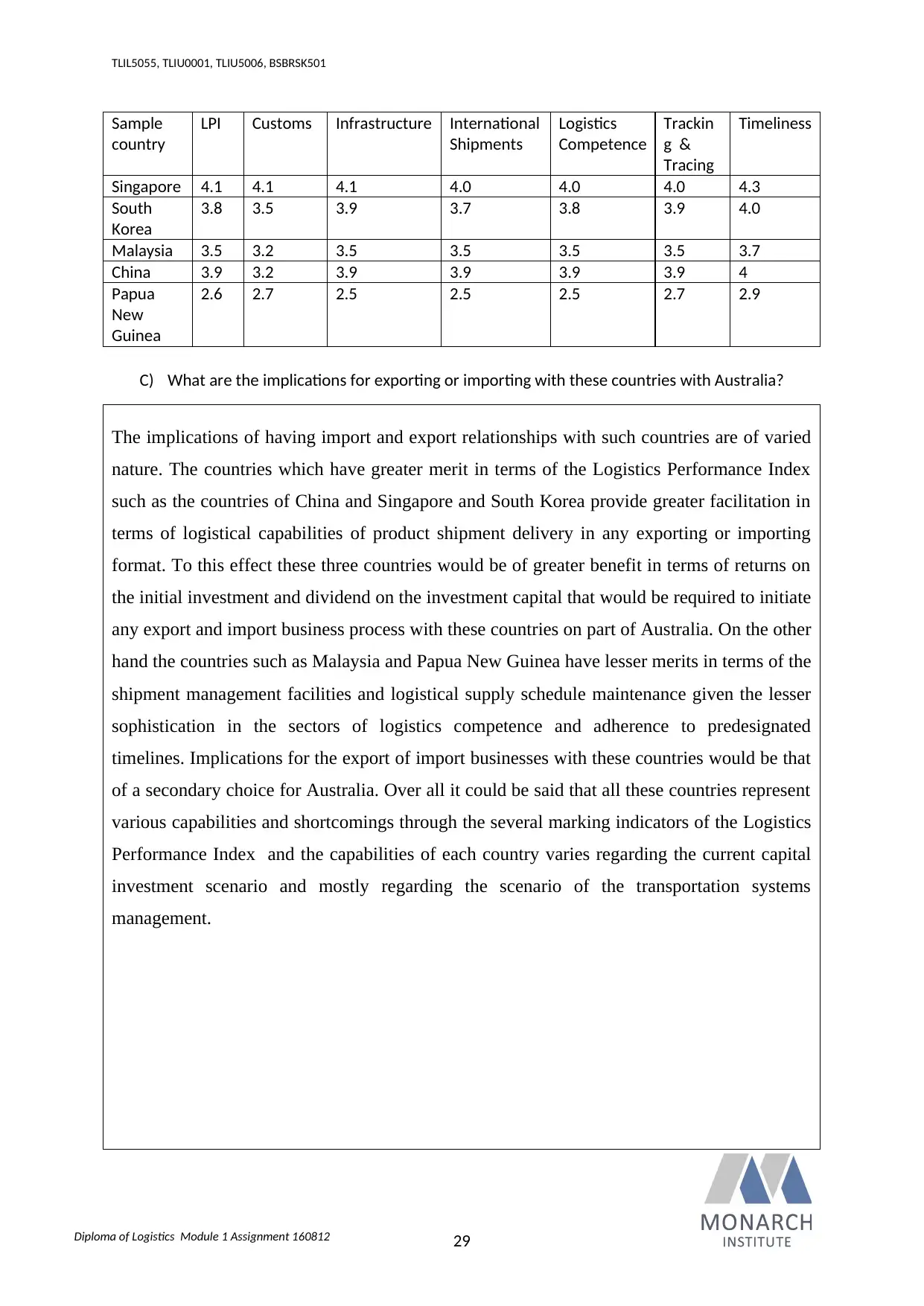
Diploma of Logistics Module 1 Assignment 160812
TLIL5055, TLIU0001, TLIU5006, BSBRSK501
Sample
country
LPI Customs Infrastructure International
Shipments
Logistics
Competence
Trackin
g &
Tracing
Timeliness
Singapore 4.1 4.1 4.1 4.0 4.0 4.0 4.3
South
Korea
3.8 3.5 3.9 3.7 3.8 3.9 4.0
Malaysia 3.5 3.2 3.5 3.5 3.5 3.5 3.7
China 3.9 3.2 3.9 3.9 3.9 3.9 4
Papua
New
Guinea
2.6 2.7 2.5 2.5 2.5 2.7 2.9
C) What are the implications for exporting or importing with these countries with Australia?
The implications of having import and export relationships with such countries are of varied
nature. The countries which have greater merit in terms of the Logistics Performance Index
such as the countries of China and Singapore and South Korea provide greater facilitation in
terms of logistical capabilities of product shipment delivery in any exporting or importing
format. To this effect these three countries would be of greater benefit in terms of returns on
the initial investment and dividend on the investment capital that would be required to initiate
any export and import business process with these countries on part of Australia. On the other
hand the countries such as Malaysia and Papua New Guinea have lesser merits in terms of the
shipment management facilities and logistical supply schedule maintenance given the lesser
sophistication in the sectors of logistics competence and adherence to predesignated
timelines. Implications for the export of import businesses with these countries would be that
of a secondary choice for Australia. Over all it could be said that all these countries represent
various capabilities and shortcomings through the several marking indicators of the Logistics
Performance Index and the capabilities of each country varies regarding the current capital
investment scenario and mostly regarding the scenario of the transportation systems
management.
29
TLIL5055, TLIU0001, TLIU5006, BSBRSK501
Sample
country
LPI Customs Infrastructure International
Shipments
Logistics
Competence
Trackin
g &
Tracing
Timeliness
Singapore 4.1 4.1 4.1 4.0 4.0 4.0 4.3
South
Korea
3.8 3.5 3.9 3.7 3.8 3.9 4.0
Malaysia 3.5 3.2 3.5 3.5 3.5 3.5 3.7
China 3.9 3.2 3.9 3.9 3.9 3.9 4
Papua
New
Guinea
2.6 2.7 2.5 2.5 2.5 2.7 2.9
C) What are the implications for exporting or importing with these countries with Australia?
The implications of having import and export relationships with such countries are of varied
nature. The countries which have greater merit in terms of the Logistics Performance Index
such as the countries of China and Singapore and South Korea provide greater facilitation in
terms of logistical capabilities of product shipment delivery in any exporting or importing
format. To this effect these three countries would be of greater benefit in terms of returns on
the initial investment and dividend on the investment capital that would be required to initiate
any export and import business process with these countries on part of Australia. On the other
hand the countries such as Malaysia and Papua New Guinea have lesser merits in terms of the
shipment management facilities and logistical supply schedule maintenance given the lesser
sophistication in the sectors of logistics competence and adherence to predesignated
timelines. Implications for the export of import businesses with these countries would be that
of a secondary choice for Australia. Over all it could be said that all these countries represent
various capabilities and shortcomings through the several marking indicators of the Logistics
Performance Index and the capabilities of each country varies regarding the current capital
investment scenario and mostly regarding the scenario of the transportation systems
management.
29
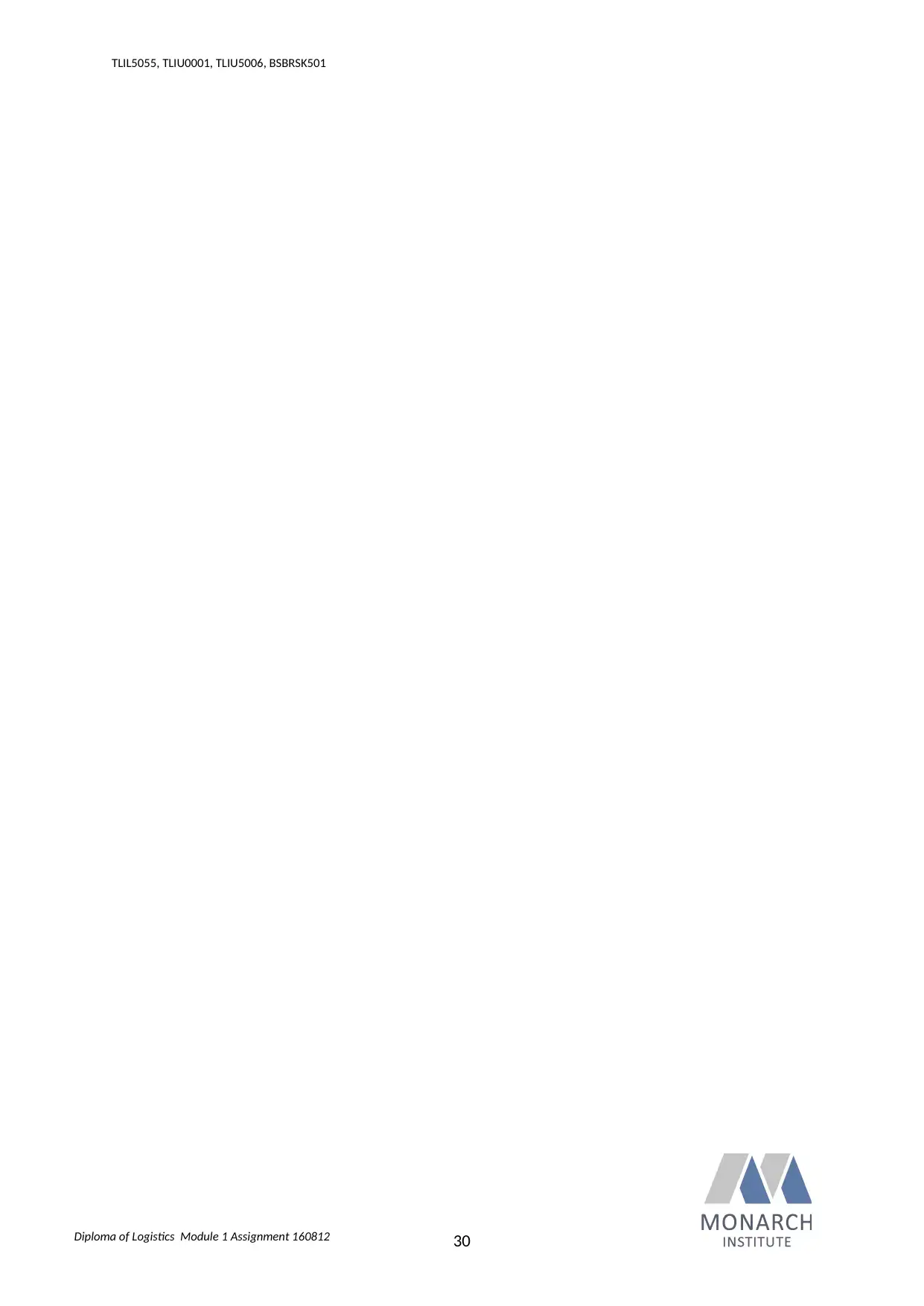
Diploma of Logistics Module 1 Assignment 160812
TLIL5055, TLIU0001, TLIU5006, BSBRSK501
30
TLIL5055, TLIU0001, TLIU5006, BSBRSK501
30
1 out of 30
Related Documents
Your All-in-One AI-Powered Toolkit for Academic Success.
+13062052269
info@desklib.com
Available 24*7 on WhatsApp / Email
![[object Object]](/_next/static/media/star-bottom.7253800d.svg)
Unlock your academic potential
© 2024 | Zucol Services PVT LTD | All rights reserved.





